-
![Н. Л. [Бутми де Кацман Георгий Васильевич]. Фран-масонство и государственная измена. Издание В. П. — СПб.: тип. газеты "Россiя", 1906. — 77 стр.](https://varshavskycollection.com/wp-content/uploads/2021/02/LIB-0940.2016-a-scaled-500x500.jpeg) Cover and title page: Н. Л. | ФРАН-МАСОНСТВО | И | ГОСУДАРСТВЕННАЯ ИЗМѢНА. | Изданiе В. П. | С.-ПЕТЕРБУРГЪ | Типографиiя газеты «Россiя». Бассейная, 3. | 1906 г. || Pagination: [1-3] 4-77 [3]; collation: [1]8 2-58; 23 x 15.5 cm, in publisher’s lettered wrappers, library and bookstore stamps. A reprint of an article published in № 4 of the magazine "Море и его Жизнь", January 1905. Allegedly a translation and a brief exposition of La franc-maçonnerie et la Révolution française by Maurice Talmeyr [Marie-Justin-Maurice Coste] (French, –
Cover and title page: Н. Л. | ФРАН-МАСОНСТВО | И | ГОСУДАРСТВЕННАЯ ИЗМѢНА. | Изданiе В. П. | С.-ПЕТЕРБУРГЪ | Типографиiя газеты «Россiя». Бассейная, 3. | 1906 г. || Pagination: [1-3] 4-77 [3]; collation: [1]8 2-58; 23 x 15.5 cm, in publisher’s lettered wrappers, library and bookstore stamps. A reprint of an article published in № 4 of the magazine "Море и его Жизнь", January 1905. Allegedly a translation and a brief exposition of La franc-maçonnerie et la Révolution française by Maurice Talmeyr [Marie-Justin-Maurice Coste] (French, – -
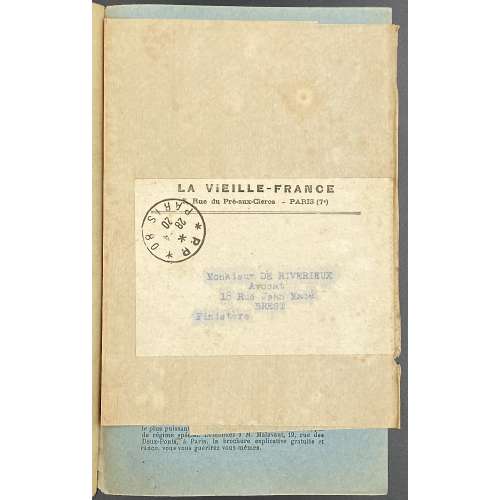 50 issues (full 1920 year) of the French anti-Semitic journal La Vieille France published by Urbain Gohier in Paris from 1916 to 1924. LIB-LIB-2731-1.2021 to LIB-2731-50.2021.
50 issues (full 1920 year) of the French anti-Semitic journal La Vieille France published by Urbain Gohier in Paris from 1916 to 1924. LIB-LIB-2731-1.2021 to LIB-2731-50.2021. -
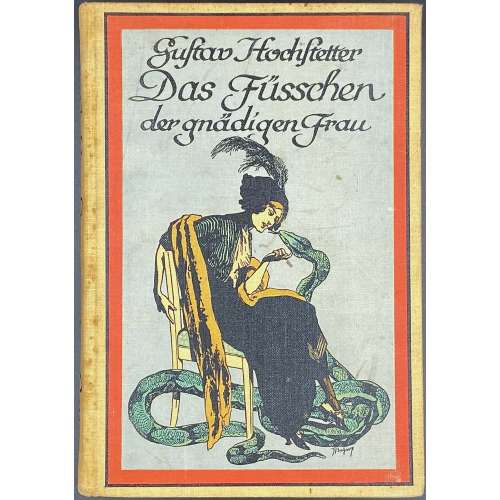 Description: Hardcover, 18.8 x 13 cm, pictorial front cover (after Franz von Bayros) in colour over tan cloth, lettering to spine, all margins red, laid paper endpapers, pp.: [4] 1-185 [3]; collated 8vo as π2 1-118, 126, total 192 pages (96 leaves) plus 5 b/w photogravures after drawings by Franz von Bayros. Title-page (blackletter): Gustav Hochstetter | Das Füsschen der gnädigen Frau | und Anderes | {publisher’s device} | {blank} | 1912 | München und Leipzig bei Georg Müller || T.p. verso (blackletter): Umschlagzeichnung und fünf Bildbeigeben von | Franz von Bayros | {blank} | (serif) Copyright 1912 by Georg Müller in München || Colophon: Druck von Mänicke u. Jahn, Rudolstadt. Contributors: Gustav Hochstetter (German-Jewish, 1873 – 1944) – author. Franz von Bayros (Austrian, 1866 – 1924) – artist. Mänicke und Jahn (Rudolstadt) – printer. Georg Müller (München, Leipzig) – publisher.
Description: Hardcover, 18.8 x 13 cm, pictorial front cover (after Franz von Bayros) in colour over tan cloth, lettering to spine, all margins red, laid paper endpapers, pp.: [4] 1-185 [3]; collated 8vo as π2 1-118, 126, total 192 pages (96 leaves) plus 5 b/w photogravures after drawings by Franz von Bayros. Title-page (blackletter): Gustav Hochstetter | Das Füsschen der gnädigen Frau | und Anderes | {publisher’s device} | {blank} | 1912 | München und Leipzig bei Georg Müller || T.p. verso (blackletter): Umschlagzeichnung und fünf Bildbeigeben von | Franz von Bayros | {blank} | (serif) Copyright 1912 by Georg Müller in München || Colophon: Druck von Mänicke u. Jahn, Rudolstadt. Contributors: Gustav Hochstetter (German-Jewish, 1873 – 1944) – author. Franz von Bayros (Austrian, 1866 – 1924) – artist. Mänicke und Jahn (Rudolstadt) – printer. Georg Müller (München, Leipzig) – publisher. -
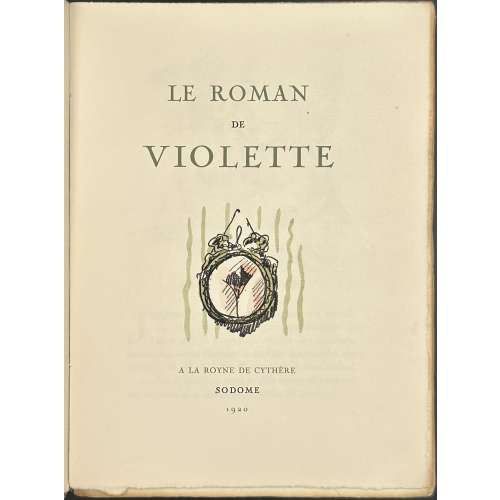 Softcover volume, 19.5 x 14.3 cm, olive French flapped wrappers, glassine dust cover, printed on laid paper (Hollande), outer and bottom margins untrimmed, some pages uncut; pagination: [2] blank, [i-iv] h.t./limit., t.p./blank, v-viii, 1-196 [197] [5], total 212 pages plus frontispiece; head- and tailpieces and in-text stencil-coloured etchings after Chéripoulos. Title-page (olive and black): LE ROMAN | DE | VIOLETTE | {vignette} | A LA ROYNE DE CYTHÈRE | SODOME | 1920 || Limitation: Cet ouvrage, achevé d'imprimer le cinq Janvier Mil Neuf Cent Vingt à trois cents exemplaires dont vingt-cinq exemplaires sur Japon Impérial contenant chacun un dessin original de Chéripoulos, numérotés de un à vingt-cinq; deux cent soixante-quinze exemplaires sur papier de Hollande, numérotés de vingt-six à trois cents; en plus cinq exemplaires de collaborateurs marqués de A à E. Le présent exemplaire porte le numéro 72. Edition: Printed on the 5th of January 1920 in 305 copies (№№ 1-25 on Japon Impérial, №№ 26-300 on Hollande, A–E for collaborators). Catalogue raisonné: Dutel III № 2339, p. 350. Contributors: Henriette de Mannoury d'Ectot [Henriette Nicolas Le Blanc] (French 1815 – 1899) Charles Auguste Edelmann [Chéripoulos] (French, 1879 – 1950).
Softcover volume, 19.5 x 14.3 cm, olive French flapped wrappers, glassine dust cover, printed on laid paper (Hollande), outer and bottom margins untrimmed, some pages uncut; pagination: [2] blank, [i-iv] h.t./limit., t.p./blank, v-viii, 1-196 [197] [5], total 212 pages plus frontispiece; head- and tailpieces and in-text stencil-coloured etchings after Chéripoulos. Title-page (olive and black): LE ROMAN | DE | VIOLETTE | {vignette} | A LA ROYNE DE CYTHÈRE | SODOME | 1920 || Limitation: Cet ouvrage, achevé d'imprimer le cinq Janvier Mil Neuf Cent Vingt à trois cents exemplaires dont vingt-cinq exemplaires sur Japon Impérial contenant chacun un dessin original de Chéripoulos, numérotés de un à vingt-cinq; deux cent soixante-quinze exemplaires sur papier de Hollande, numérotés de vingt-six à trois cents; en plus cinq exemplaires de collaborateurs marqués de A à E. Le présent exemplaire porte le numéro 72. Edition: Printed on the 5th of January 1920 in 305 copies (№№ 1-25 on Japon Impérial, №№ 26-300 on Hollande, A–E for collaborators). Catalogue raisonné: Dutel III № 2339, p. 350. Contributors: Henriette de Mannoury d'Ectot [Henriette Nicolas Le Blanc] (French 1815 – 1899) Charles Auguste Edelmann [Chéripoulos] (French, 1879 – 1950). -
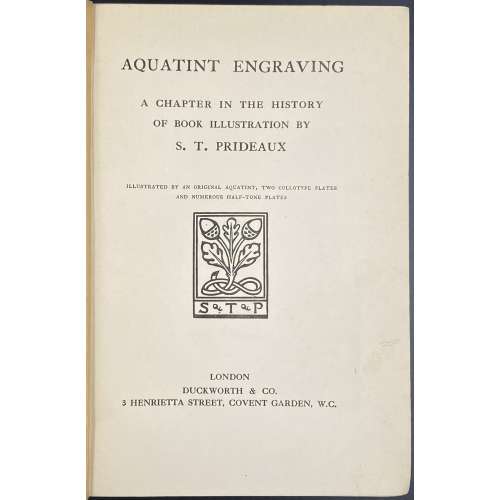 Half-title: AQUATINT ENGRAVING || Title: AQUATINT ENGRAVING | A CHAPTER IN THE HISTORY | OF BOOK ILLUSTRATION BY | S. T. PRIDEAUX | ILLUSTRATED BY AN ORIGINAL AQUATINT, TWO COLLOTYPE PLATES | AND NUMEROUS HALF-TONE PLATES | [Prideaux device] | LONDON | DUCKWORTH & CO. | 3 HENRIETTA STREET, COVENT GARDEN, W.C. || Pagination: ffl, [i, ii] – h.t. / blank, [2] – blank / frontis. w/guard, [iii, iv] – t.p. / coloph. "First Published, December 1909", [v, vi] – dedication "TO MY FATHER" / blank, vii-xv [xvi], [1] 2-434, bfl, + 24 pl. (incl. port). Collation: [a]6 b8 A-Z8 2A-2C8 2D4 Binding: Original navy cloth, gilt-ruled and lettered front board, gilt lettering to spine, a blind device to back board; upper margin gilt, free margin untrimmed. Author: Sarah Prideaux. "Engravers and the books they illustrated": p. 388-405. "Publications by Ackermann with aquatint plates": p. 374-378. "Biographical notices of engravers whose names appear on the plates": p. 358-371. "Books published before 1830 with aquatint plates": p. 325-357.
Half-title: AQUATINT ENGRAVING || Title: AQUATINT ENGRAVING | A CHAPTER IN THE HISTORY | OF BOOK ILLUSTRATION BY | S. T. PRIDEAUX | ILLUSTRATED BY AN ORIGINAL AQUATINT, TWO COLLOTYPE PLATES | AND NUMEROUS HALF-TONE PLATES | [Prideaux device] | LONDON | DUCKWORTH & CO. | 3 HENRIETTA STREET, COVENT GARDEN, W.C. || Pagination: ffl, [i, ii] – h.t. / blank, [2] – blank / frontis. w/guard, [iii, iv] – t.p. / coloph. "First Published, December 1909", [v, vi] – dedication "TO MY FATHER" / blank, vii-xv [xvi], [1] 2-434, bfl, + 24 pl. (incl. port). Collation: [a]6 b8 A-Z8 2A-2C8 2D4 Binding: Original navy cloth, gilt-ruled and lettered front board, gilt lettering to spine, a blind device to back board; upper margin gilt, free margin untrimmed. Author: Sarah Prideaux. "Engravers and the books they illustrated": p. 388-405. "Publications by Ackermann with aquatint plates": p. 374-378. "Biographical notices of engravers whose names appear on the plates": p. 358-371. "Books published before 1830 with aquatint plates": p. 325-357. -
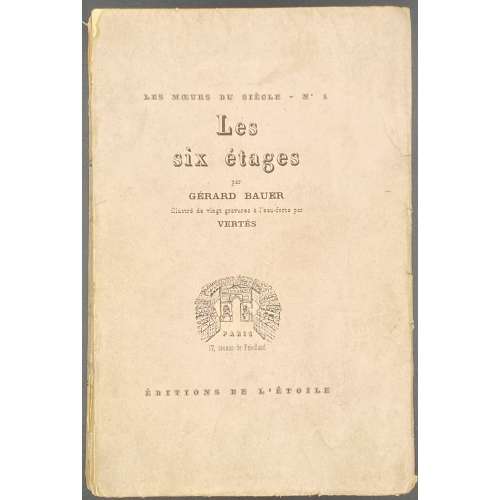 Front wrapper: LES MŒURS DU SIECLE - № 1 | Les | six étages | par | GERARD BAUER | illustré de vingt gravures à l’eau-forte | par VERTÈS | {publisher’s device, “PARIS | 17, avenue de Friedland”} | ÉDITIONS DE L’ÉTOILE || Title-page: essais pour servir a1 l’histoire contemporaine | de la galanterie et du plaisir | I | Les six étages | par | GERARD BAUER | illustré de vingt gravures à l’eau-forte | par VERTÈS | | {publisher’s device, “ÉDITIONS DE L’ÉTOILE | 17, avenue de Friedland”} | PARIS […] MCMXXV || Pagination: front wrapper with lettering, [1-8] incl. 1st bank leaf, h.t. / limitation, t.p. / blank, dedication to Abel Hermant / blank, 9-169 [170] [6] incl. table, colophon, and last blank leaf, 17 etchings by Vertès within pagination; advert. of the other books of the series to the back wrapper. Edition: 15 copies on Japon Impérial (№ 1-15), 35 on Hollande Van Gelder Zonen (№ 16-50), 400 on Vélin de Rives BFK (№ 51-450) and 3 on blue paper not for sale. This copy is № 369. Printed on November 10, 1925 by L. Petitbarat in Saint-Ouen-l’Aumône (text) and by Vernant in Paris (etchings). Edition directed by Roger Allard. Binding: 19 x 12.5 cm, French flapped pink wrappers, lettered to front, back, and spine. Contributors: Gérard Bauër (French, 1888 – 1967) – author. Marcel Vertès [Marcell Vértes] (Jewish-Hungarian-French, 1895 – 1961) – artist. Abel Hermant (French, 1862 – 1950) – dedicatee. Roger Allard (French, 1885 – 1961) – editor. L. Petitbarat (Saint-Ouen-l’Aumône) – printer. Éditions de l’Étoile (Paris) – publisher. Other names: Marcel Vertès, Marcel Vertes, Marcell Vértes
Front wrapper: LES MŒURS DU SIECLE - № 1 | Les | six étages | par | GERARD BAUER | illustré de vingt gravures à l’eau-forte | par VERTÈS | {publisher’s device, “PARIS | 17, avenue de Friedland”} | ÉDITIONS DE L’ÉTOILE || Title-page: essais pour servir a1 l’histoire contemporaine | de la galanterie et du plaisir | I | Les six étages | par | GERARD BAUER | illustré de vingt gravures à l’eau-forte | par VERTÈS | | {publisher’s device, “ÉDITIONS DE L’ÉTOILE | 17, avenue de Friedland”} | PARIS […] MCMXXV || Pagination: front wrapper with lettering, [1-8] incl. 1st bank leaf, h.t. / limitation, t.p. / blank, dedication to Abel Hermant / blank, 9-169 [170] [6] incl. table, colophon, and last blank leaf, 17 etchings by Vertès within pagination; advert. of the other books of the series to the back wrapper. Edition: 15 copies on Japon Impérial (№ 1-15), 35 on Hollande Van Gelder Zonen (№ 16-50), 400 on Vélin de Rives BFK (№ 51-450) and 3 on blue paper not for sale. This copy is № 369. Printed on November 10, 1925 by L. Petitbarat in Saint-Ouen-l’Aumône (text) and by Vernant in Paris (etchings). Edition directed by Roger Allard. Binding: 19 x 12.5 cm, French flapped pink wrappers, lettered to front, back, and spine. Contributors: Gérard Bauër (French, 1888 – 1967) – author. Marcel Vertès [Marcell Vértes] (Jewish-Hungarian-French, 1895 – 1961) – artist. Abel Hermant (French, 1862 – 1950) – dedicatee. Roger Allard (French, 1885 – 1961) – editor. L. Petitbarat (Saint-Ouen-l’Aumône) – printer. Éditions de l’Étoile (Paris) – publisher. Other names: Marcel Vertès, Marcel Vertes, Marcell Vértes -
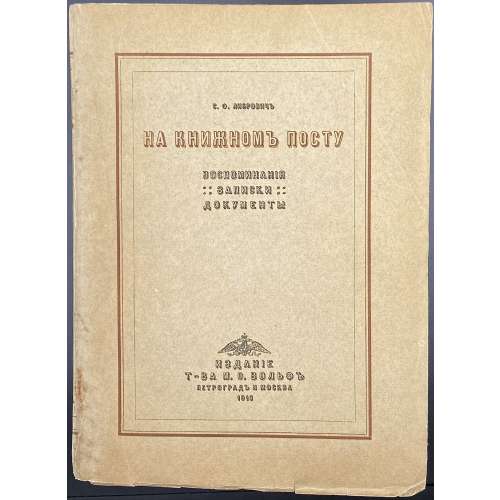 Softcover volume, 24.0 x 17.7 cm, publisher’s tan wrappers, lettered to front and spine in brown and black, publisher’s device and imprint to back, upper margin trimmed, all printed on laid paper, pp: [i-viii] [1-3] 4-496 [4], last page blank (total 508 pages); collated 8vo: π4 1-318 χ2 (total 254 leaves). Book-label with publisher’s device to fep (χ1 recto). Title-page and front wrapper (in brown and black): С. Ф. ЛИБРОВИЧЪ | НА КНИЖНОМЪ ПОСТУ | ВОСПОМИНАНIЯ | : : ЗАПИСКИ : : | ДОКУМЕНТЫ | {two-headed eagle} | ИЗДАНIЕ | Т-ВА М. О. ВОЛЬФЪ | ПЕТРОГРАДЪ И МОСКВА | (1916 on front wrapper) || Provenance: Publisher Contributors: Сигизмунд Феликсович Либрович [Zygmunt Librowicz] (Polish-Russian, 1855 – 1918) – author. Товарищество М. О. Вольф (Петроград-Москва) – publisher. Типография товарищества М. О. Вольф (Петроград) – printer. Маврикий Осипович Вольф [Maurycy Bolesław Wolff] (Polish-Russian, 1825 – 1883) – dedicatee.
Softcover volume, 24.0 x 17.7 cm, publisher’s tan wrappers, lettered to front and spine in brown and black, publisher’s device and imprint to back, upper margin trimmed, all printed on laid paper, pp: [i-viii] [1-3] 4-496 [4], last page blank (total 508 pages); collated 8vo: π4 1-318 χ2 (total 254 leaves). Book-label with publisher’s device to fep (χ1 recto). Title-page and front wrapper (in brown and black): С. Ф. ЛИБРОВИЧЪ | НА КНИЖНОМЪ ПОСТУ | ВОСПОМИНАНIЯ | : : ЗАПИСКИ : : | ДОКУМЕНТЫ | {two-headed eagle} | ИЗДАНIЕ | Т-ВА М. О. ВОЛЬФЪ | ПЕТРОГРАДЪ И МОСКВА | (1916 on front wrapper) || Provenance: Publisher Contributors: Сигизмунд Феликсович Либрович [Zygmunt Librowicz] (Polish-Russian, 1855 – 1918) – author. Товарищество М. О. Вольф (Петроград-Москва) – publisher. Типография товарищества М. О. Вольф (Петроград) – printer. Маврикий Осипович Вольф [Maurycy Bolesław Wolff] (Polish-Russian, 1825 – 1883) – dedicatee. -
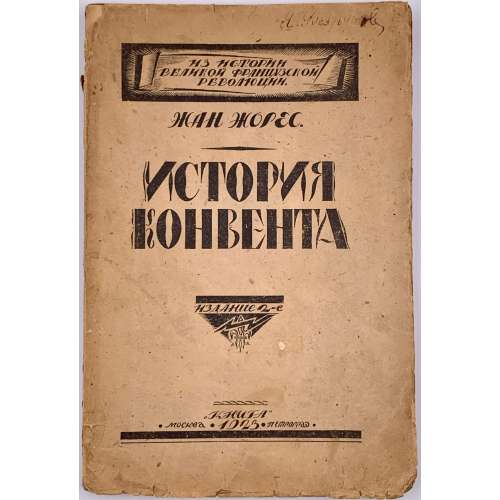 Cover: ИЗ ИСТОРИИ | ВЕЛИКОЙ ФРАНЦУЗСКОЙ | РЕВОЛЮЦИИ | ЖАН ЖОРЕС | ИСТОРИЯ КОНВЕНТА | ИЗДАНИЕ 2-е | “Книга” | • МОСКВА • 1923 • ПЕТРОГРАД • || Title page: Жан Жорес | История Конвента | Сокращенный перевод В. Левицкого | под редакцией Ф. Дана. | Второе издание. | {publisher’s device} | “Книга” | Москва. […] Петроград | Тверская, 38, тел. 2-64-61. […] Невский, 74, тел. 1-34-34. || Print run: 3,000 copies. Printer: 10-я типография МСНХ «Мосполиграф». Original Title: Histoire socialiste : 1789-1900. La convention nationale / par J. Jaurès. — Paris : Jules Rouff et Cie, 1901 Bibliographical description: 23.5 x 16 cm, publisher’s letterpress wrappers, pp. [1-3] 4-191 [192]; collation: 8vo, [1-2]8 3-128; ink inscription to front wrapper: Я. Безруков Jean Jaurès [Жан Жорес] (French, 1859 – 1914) Цедербаум, Владимир Осипович [Левицкий, В.] (Russian-Jewish, 1883 – 1938) Дан [Гурвич], Федор Ильич (Russian-Jewish, 1871-1947)
Cover: ИЗ ИСТОРИИ | ВЕЛИКОЙ ФРАНЦУЗСКОЙ | РЕВОЛЮЦИИ | ЖАН ЖОРЕС | ИСТОРИЯ КОНВЕНТА | ИЗДАНИЕ 2-е | “Книга” | • МОСКВА • 1923 • ПЕТРОГРАД • || Title page: Жан Жорес | История Конвента | Сокращенный перевод В. Левицкого | под редакцией Ф. Дана. | Второе издание. | {publisher’s device} | “Книга” | Москва. […] Петроград | Тверская, 38, тел. 2-64-61. […] Невский, 74, тел. 1-34-34. || Print run: 3,000 copies. Printer: 10-я типография МСНХ «Мосполиграф». Original Title: Histoire socialiste : 1789-1900. La convention nationale / par J. Jaurès. — Paris : Jules Rouff et Cie, 1901 Bibliographical description: 23.5 x 16 cm, publisher’s letterpress wrappers, pp. [1-3] 4-191 [192]; collation: 8vo, [1-2]8 3-128; ink inscription to front wrapper: Я. Безруков Jean Jaurès [Жан Жорес] (French, 1859 – 1914) Цедербаум, Владимир Осипович [Левицкий, В.] (Russian-Jewish, 1883 – 1938) Дан [Гурвич], Федор Ильич (Russian-Jewish, 1871-1947) -
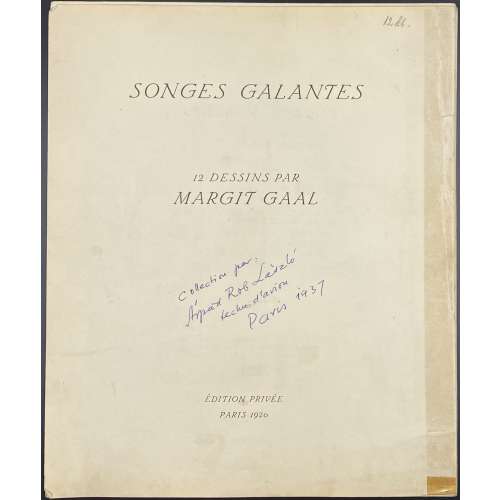 In an owner’s quarter buckram cardboard folder with a vegetation diaper design, ms blue ink lettering to front: “Songes galantes | 12 dessins par | Margit Gaal” at the centre, “Arpad Rob Laszlo | à Paris | 1938” in the lower right corner. Loose sheets with the 1st leaf t.p. / table de planches, and then 12 leaves of lithograph plates. Title-page: SONGES GALANTES | 12 DESSINS PAR | MARGIT GAAL | ÉDITION PRIVÉE | PARIS 1920 ||, ms inscription in blue ink in the middle : “Collection par | Árpad Rob Laśzló | techn. d’avion | Paris 1937”. Limitation: Edition limited to 500 copies of which № 1-100 signed by the author. This is copy № 407. References: Dutel (1920-1970) № 1413 (published in 1921); Honesterotica (indicated the year of death as 1965, however, there is no proof). Contributors: Gaál, Margit (Hungarian, 1898 – 1920) – artist.
In an owner’s quarter buckram cardboard folder with a vegetation diaper design, ms blue ink lettering to front: “Songes galantes | 12 dessins par | Margit Gaal” at the centre, “Arpad Rob Laszlo | à Paris | 1938” in the lower right corner. Loose sheets with the 1st leaf t.p. / table de planches, and then 12 leaves of lithograph plates. Title-page: SONGES GALANTES | 12 DESSINS PAR | MARGIT GAAL | ÉDITION PRIVÉE | PARIS 1920 ||, ms inscription in blue ink in the middle : “Collection par | Árpad Rob Laśzló | techn. d’avion | Paris 1937”. Limitation: Edition limited to 500 copies of which № 1-100 signed by the author. This is copy № 407. References: Dutel (1920-1970) № 1413 (published in 1921); Honesterotica (indicated the year of death as 1965, however, there is no proof). Contributors: Gaál, Margit (Hungarian, 1898 – 1920) – artist. -
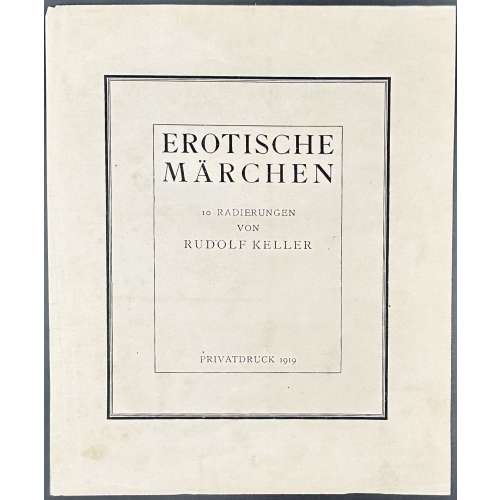 Portfolio 265 x 225 mm, black half-buckram over diapered cardboard with flaps, black with gilt lettering in frame to front “R. KELLER | MÄRCHEN”, t.p. printed on wave paper, the folder and engravings printed on laid paper, 10 loose plates, 240 x 210 mm sheet, 135 x 110-115 mm plate; re-issue of ten plates of the first edition of 16 plates published in Austria in c. 1910s. Title-page: EROTISCHE | MÄRCHEN | 10 RADIERUNGEN | VON | RUDOLF KELLER | PRIVATDRUCK 1919 || Die Mappe enthält folgende originalradierungen: 1. Aschenbrödel; 2. Dornröschen; 3. Zwerg Nase; 4. Froschkönig; 5. Der gestiefelte Kater; 6. Hänsel und Gretel; 7. Der fliegende Koffer; 8. Schneewittchen mit den 7 Zwergen; 9. Die kleine Seejungfer; 10. Der kleine Daumling Dieses Werk wurde in einer einmaligen Auflage von 250 numerierten Exemplaren hergestellt und darf nur an Gelehrte und Sammler abgegeben werden. Die Platten wurden vernichtet. Nr. 1—50 sind vom Künstler signierte Vorzugsdrucke. Dieses Exemplar erhielt Nr. 0153. Translation: The folder contains the following original etchings: 1. Cinderella; 2. Sleeping Beauty; 3. Dwarf nose; 4. The Frog Prince; 5. Puss in Boots; 6. Hansel and Gretel; 7. The Flying Trunk; 8. Snow White with the Seven Dwarfs; 9. The Little Mermaid; 10. Little Thumbling. This work was produced in a one-time edition of 250 numbered copies and may only be sold to scholars and collectors. The copperplates were destroyed. Nos. 1-50 are special prints signed by the artist. This copy was given number 0153. Seller's description: Erotische Märchen. S.l., Privatdruck, 1919. In-8, en feuilles, sous chemise demi-chagrin vert recouverte de papier japonais. Recueil de 10 eaux-fortes originales de Rudolf Keller. Ces eaux-fortes érotiques dans les teintes brunes s'inspirent des contes de fées traditionnels comme Cendrillon, La Belle au bois dormant, Hansel et Gretel, Blanche-Neige, Le Petit Poucet etc. Tirage à 250 exemplaires. Chemise défraîchie. Jacob Grimm (German; 1785 – 1863) Wilhelm Grimm (German, 1786 – 1859) Charles Perrault (French, 1628 – 1703) Hans Christian Andersen (Danish, 1805 – 1875)
Portfolio 265 x 225 mm, black half-buckram over diapered cardboard with flaps, black with gilt lettering in frame to front “R. KELLER | MÄRCHEN”, t.p. printed on wave paper, the folder and engravings printed on laid paper, 10 loose plates, 240 x 210 mm sheet, 135 x 110-115 mm plate; re-issue of ten plates of the first edition of 16 plates published in Austria in c. 1910s. Title-page: EROTISCHE | MÄRCHEN | 10 RADIERUNGEN | VON | RUDOLF KELLER | PRIVATDRUCK 1919 || Die Mappe enthält folgende originalradierungen: 1. Aschenbrödel; 2. Dornröschen; 3. Zwerg Nase; 4. Froschkönig; 5. Der gestiefelte Kater; 6. Hänsel und Gretel; 7. Der fliegende Koffer; 8. Schneewittchen mit den 7 Zwergen; 9. Die kleine Seejungfer; 10. Der kleine Daumling Dieses Werk wurde in einer einmaligen Auflage von 250 numerierten Exemplaren hergestellt und darf nur an Gelehrte und Sammler abgegeben werden. Die Platten wurden vernichtet. Nr. 1—50 sind vom Künstler signierte Vorzugsdrucke. Dieses Exemplar erhielt Nr. 0153. Translation: The folder contains the following original etchings: 1. Cinderella; 2. Sleeping Beauty; 3. Dwarf nose; 4. The Frog Prince; 5. Puss in Boots; 6. Hansel and Gretel; 7. The Flying Trunk; 8. Snow White with the Seven Dwarfs; 9. The Little Mermaid; 10. Little Thumbling. This work was produced in a one-time edition of 250 numbered copies and may only be sold to scholars and collectors. The copperplates were destroyed. Nos. 1-50 are special prints signed by the artist. This copy was given number 0153. Seller's description: Erotische Märchen. S.l., Privatdruck, 1919. In-8, en feuilles, sous chemise demi-chagrin vert recouverte de papier japonais. Recueil de 10 eaux-fortes originales de Rudolf Keller. Ces eaux-fortes érotiques dans les teintes brunes s'inspirent des contes de fées traditionnels comme Cendrillon, La Belle au bois dormant, Hansel et Gretel, Blanche-Neige, Le Petit Poucet etc. Tirage à 250 exemplaires. Chemise défraîchie. Jacob Grimm (German; 1785 – 1863) Wilhelm Grimm (German, 1786 – 1859) Charles Perrault (French, 1628 – 1703) Hans Christian Andersen (Danish, 1805 – 1875) -
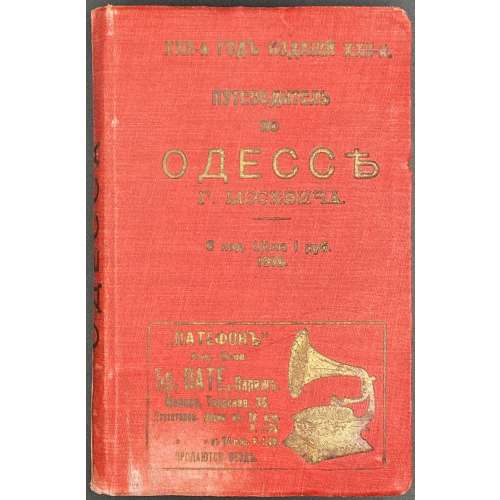 Title: Издательство Путеводителей "Русскiй Бедекеръ" сущ. съ 1888 г. | Григорiй Москвичъ. | ИЛЛЮСТРИРОВАННЫЙ | Практический Путеводитель | по Одессѣ | с приложенiемъ: | очерка одесской выставки, плана Одессы, исполненнаго | в краскахъ, плановъ — порта, Куяльницкаго лимана, | расписанiя рейсовъ пароходовъ и тарифовъ, алфавита | и проч. | ИЗДАНИIЕ ШЕСТОЕ. | Цѣна 1 руб. (в переплетѣ) | ПРОДАЕТСЯ | во всѣх лучшихъ книжныхъ магазинахъ столицъ | и провинцiи. | ОДЕССА. | Типографiя и стереотипия И. Копельмана, Пушк. 34. | 1910. || Binding: Red cloth with gilt lettering to the front board: XXII-й ГОДЪ ИЗДАНIЯ XXII-й | ПУТЕВОДИТЕЛЬ | ПО | ОДЕССѢ | Г. МОСКВИЧА. | 6 изд. Цѣна 1 руб. | 1910. [Pictorial advert.], to the back board: Text. advert. in gilt; to spine: ОДЕССА. Pink end-papers with advertisement. Pagination: [i-ii - t.p. /advert.] [iii]-iv - preface to 6th edition; [v]-viii - content; [ix]-xvi - index; 11 leaves advert., unpag; [i]-xii - Odessa exhibition; [1] 2-240; [1] 2-8 - schedules; photo plates, 2 folding maps; in-16mo (numerical). Size: 16.5 x 10.5 cm.
Title: Издательство Путеводителей "Русскiй Бедекеръ" сущ. съ 1888 г. | Григорiй Москвичъ. | ИЛЛЮСТРИРОВАННЫЙ | Практический Путеводитель | по Одессѣ | с приложенiемъ: | очерка одесской выставки, плана Одессы, исполненнаго | в краскахъ, плановъ — порта, Куяльницкаго лимана, | расписанiя рейсовъ пароходовъ и тарифовъ, алфавита | и проч. | ИЗДАНИIЕ ШЕСТОЕ. | Цѣна 1 руб. (в переплетѣ) | ПРОДАЕТСЯ | во всѣх лучшихъ книжныхъ магазинахъ столицъ | и провинцiи. | ОДЕССА. | Типографiя и стереотипия И. Копельмана, Пушк. 34. | 1910. || Binding: Red cloth with gilt lettering to the front board: XXII-й ГОДЪ ИЗДАНIЯ XXII-й | ПУТЕВОДИТЕЛЬ | ПО | ОДЕССѢ | Г. МОСКВИЧА. | 6 изд. Цѣна 1 руб. | 1910. [Pictorial advert.], to the back board: Text. advert. in gilt; to spine: ОДЕССА. Pink end-papers with advertisement. Pagination: [i-ii - t.p. /advert.] [iii]-iv - preface to 6th edition; [v]-viii - content; [ix]-xvi - index; 11 leaves advert., unpag; [i]-xii - Odessa exhibition; [1] 2-240; [1] 2-8 - schedules; photo plates, 2 folding maps; in-16mo (numerical). Size: 16.5 x 10.5 cm. -
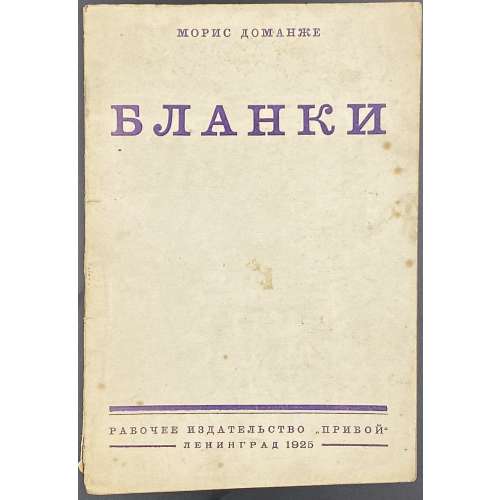 Cover: МОРИС ДОМАНЖЕ | БЛАНКИ | РАБОЧЕЕ ИЗДАТЕЛЬСТВО “ПРИБОЙ” | ЛЕНИНГРАД 1925 || Title page: МОРИС ДОМАНЖЕ | БЛАНКИ | Пер. с французского | Рабочее Издательство “ПРИБОЙ” | Ленинград 1925 || Pagination: [2] 3-97 [3]. Collation: 8vo; [1]8 2-68 [7]2, total 50 leaves. Binding: Publisher’s wrappers, lettering to covers and spine, uncut. Contributor: Maurice Dommanget (French, 1888 – 1976) – author. Translation of: Blanqui par Maurice Dommanget. — Paris: Librairie de l'Humanité, 1924.
Cover: МОРИС ДОМАНЖЕ | БЛАНКИ | РАБОЧЕЕ ИЗДАТЕЛЬСТВО “ПРИБОЙ” | ЛЕНИНГРАД 1925 || Title page: МОРИС ДОМАНЖЕ | БЛАНКИ | Пер. с французского | Рабочее Издательство “ПРИБОЙ” | Ленинград 1925 || Pagination: [2] 3-97 [3]. Collation: 8vo; [1]8 2-68 [7]2, total 50 leaves. Binding: Publisher’s wrappers, lettering to covers and spine, uncut. Contributor: Maurice Dommanget (French, 1888 – 1976) – author. Translation of: Blanqui par Maurice Dommanget. — Paris: Librairie de l'Humanité, 1924. -
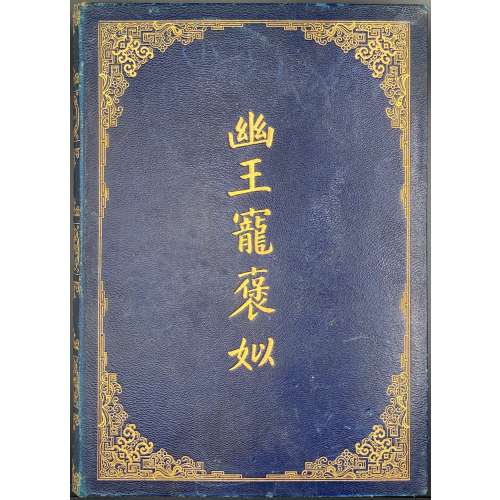 Description: Hardcover, in-folio, 32 x 23.5 cm, bound in dark blue morocco, boards and spine richly decorated in gilt, front cover gilt-lettered in Chinese [幽王寵褒姒], pictorial endpapers, laid paper with unicorn watermark, margins uncut, printing performed by Joh. Enschedé (Haarlem), pp. [10] 1-210 [6], total 226 pages, collated π5 1-532 χ2, first and last leaves blank, total 113 leaves plus 7 plates after Franz von Bayros, some signed; adorned with woodcut borders, frames, head- and tailpieces throughout. The binding work was done by Hübel und Denck (Leipzig) based on designs by Paul Renner. Title-page: DAS | SCHÖNE | MÄDCHEN | VON PAO | — | EIN CHINESISCHER | ROMAN VON | OTTO JULIUS BIERBAUM | — | PRACHTAUSGABE | MIT BILDERN VON BAYROS | — | Bei Joh. Enschedé en Zonen in | Haarlem gedruckt für Georg | Müllers Verlag in München || Catalogue raisonné: The amorous drawings of the Marquis von Bayros. — New York: Cythera Press, 1968. The Beautiful Maiden of Pao, pp. 153-8. Contributors: Otto Julius Bierbaum (German, 1865 – 1910) – author. Franz von Bayros (Austrian, 1866 – 1924) – artist. Johannes Enschedé (Dutch, 1708 – 1780) – printer. Joh. Enschedé (Haarlem) – printer. Hübel und Denck (Leipzig) – bookbinder. Paul Friedrich August Renner (German, 1878 – 1956) – designer.
Description: Hardcover, in-folio, 32 x 23.5 cm, bound in dark blue morocco, boards and spine richly decorated in gilt, front cover gilt-lettered in Chinese [幽王寵褒姒], pictorial endpapers, laid paper with unicorn watermark, margins uncut, printing performed by Joh. Enschedé (Haarlem), pp. [10] 1-210 [6], total 226 pages, collated π5 1-532 χ2, first and last leaves blank, total 113 leaves plus 7 plates after Franz von Bayros, some signed; adorned with woodcut borders, frames, head- and tailpieces throughout. The binding work was done by Hübel und Denck (Leipzig) based on designs by Paul Renner. Title-page: DAS | SCHÖNE | MÄDCHEN | VON PAO | — | EIN CHINESISCHER | ROMAN VON | OTTO JULIUS BIERBAUM | — | PRACHTAUSGABE | MIT BILDERN VON BAYROS | — | Bei Joh. Enschedé en Zonen in | Haarlem gedruckt für Georg | Müllers Verlag in München || Catalogue raisonné: The amorous drawings of the Marquis von Bayros. — New York: Cythera Press, 1968. The Beautiful Maiden of Pao, pp. 153-8. Contributors: Otto Julius Bierbaum (German, 1865 – 1910) – author. Franz von Bayros (Austrian, 1866 – 1924) – artist. Johannes Enschedé (Dutch, 1708 – 1780) – printer. Joh. Enschedé (Haarlem) – printer. Hübel und Denck (Leipzig) – bookbinder. Paul Friedrich August Renner (German, 1878 – 1956) – designer. -
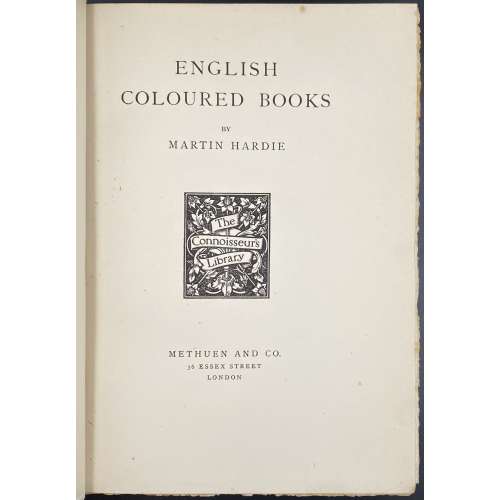 Half-title: THE CONNOISSEURS LIBRARY | GENERAL EDITOR : CYRIL DAVENPORT | […] | ENGLISH COLOURED BOOKS || Title: ENGLISH | COLOURED BOOKS | BY | MARTIN HARDIE | [device: THE CONNOISSEURS LIBRARY] | METHUEN AND CO. | 36 ESSEX STREET | LONDON || Dedication: TO MY WIFE | LOVE’S LABOUR : LOVE’S GIFT Pagination: ffl [i, ii] – h.t. / blank, [2] – blank / frontis. In colour, [iii, iv] – t.p. / First Published in 1906, [v, vi] – dedication / blank, vii-xxiv; 1-339 [340] bfl; 27 sheets of plates, colour and b/w. Collation: 8vo; a8 b4 A-X8 Y2. Binding: Hardcover, 26.3 x 19 x 5.7 cm; red cloth, blind-stamped with repeated fleuron, gilt floral designs and lettering in the frame to front cover, elaborate gilt floral design and lettering to spine; top margin gilt, other untrimmed, some pages uncut; plates w/guards. Printed on laid paper. Printed in Scotland by T. and A. Constable, at the Edinburgh university press. Contributors: Martin Hardie (British, 1875 – 1952) – Author Cyril Davenport (British, 1848 – 1941) – Editor of the series Sir Algernon Methuen (British, 1856 – 1924) – Publisher Thomas Constable (British, 1812 – 1881); Archibald Constable (British, 1774 – 1827) – Founders of the Publishing House "T. and A. Constable".
Half-title: THE CONNOISSEURS LIBRARY | GENERAL EDITOR : CYRIL DAVENPORT | […] | ENGLISH COLOURED BOOKS || Title: ENGLISH | COLOURED BOOKS | BY | MARTIN HARDIE | [device: THE CONNOISSEURS LIBRARY] | METHUEN AND CO. | 36 ESSEX STREET | LONDON || Dedication: TO MY WIFE | LOVE’S LABOUR : LOVE’S GIFT Pagination: ffl [i, ii] – h.t. / blank, [2] – blank / frontis. In colour, [iii, iv] – t.p. / First Published in 1906, [v, vi] – dedication / blank, vii-xxiv; 1-339 [340] bfl; 27 sheets of plates, colour and b/w. Collation: 8vo; a8 b4 A-X8 Y2. Binding: Hardcover, 26.3 x 19 x 5.7 cm; red cloth, blind-stamped with repeated fleuron, gilt floral designs and lettering in the frame to front cover, elaborate gilt floral design and lettering to spine; top margin gilt, other untrimmed, some pages uncut; plates w/guards. Printed on laid paper. Printed in Scotland by T. and A. Constable, at the Edinburgh university press. Contributors: Martin Hardie (British, 1875 – 1952) – Author Cyril Davenport (British, 1848 – 1941) – Editor of the series Sir Algernon Methuen (British, 1856 – 1924) – Publisher Thomas Constable (British, 1812 – 1881); Archibald Constable (British, 1774 – 1827) – Founders of the Publishing House "T. and A. Constable". -
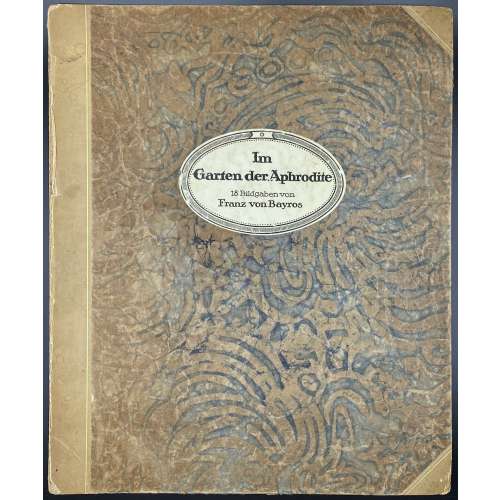 Cover with title: Im Garten der Aphrodite | 18 Bildgaben | von | Franz von Bayros | {vignette} | Privatdruck || in a frame; table of contents and limitation to verso; 18 plates with the drawings of Bayros in collotype reproduction, each mounted on cardboard and protected with the remnants of tissue guards, some lacking. Of the publisher’s folder, only the front board with an oval title label is present. Some images signed “Choisy le Conin” – von Bayros’s pseudonym. Two prints are missing: (1) Das Füßchen and (2) Die Liebesschaukel, the other 16 prints present. The vignette on the cover is a photomechanical reproduction. Edition: limited to 350 copies of which this is № 253. According to Christie’s: a collotype reprint, about twenty years after their first publication. English equivalent: The Garden of Aphrodite. Portfolio with 18 photogravures. Catalogue raisonné: The amorous drawings of the Marquis von Bayros (1968): pp. 177-1877; Bayros Zeichningen (1987): pp. 143-152.
Cover with title: Im Garten der Aphrodite | 18 Bildgaben | von | Franz von Bayros | {vignette} | Privatdruck || in a frame; table of contents and limitation to verso; 18 plates with the drawings of Bayros in collotype reproduction, each mounted on cardboard and protected with the remnants of tissue guards, some lacking. Of the publisher’s folder, only the front board with an oval title label is present. Some images signed “Choisy le Conin” – von Bayros’s pseudonym. Two prints are missing: (1) Das Füßchen and (2) Die Liebesschaukel, the other 16 prints present. The vignette on the cover is a photomechanical reproduction. Edition: limited to 350 copies of which this is № 253. According to Christie’s: a collotype reprint, about twenty years after their first publication. English equivalent: The Garden of Aphrodite. Portfolio with 18 photogravures. Catalogue raisonné: The amorous drawings of the Marquis von Bayros (1968): pp. 177-1877; Bayros Zeichningen (1987): pp. 143-152. -
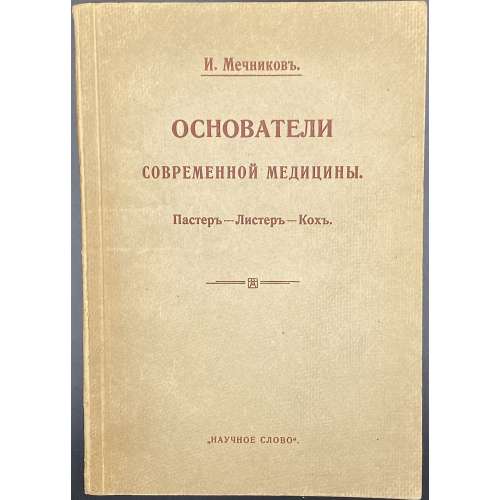 Paperback, 22.3 x 15.5 cm, publisher’s tan wrappers, brown lettering to front and spine, imprint and price to back, pp.: [1-3] 4-136 [2] blank/advert.; collated 8vo: [1]-88, 94 χ1, total 69 leaves plus 6 photomechanical plates, incl. frontispiece, four of them portraits. Title-page: И. Мечниковъ | ОСНОВАТЕЛИ | СОВРЕМЕННОЙ МЕДИЦИНЫ. | Пастеръ. — Листеръ. — Кохъ. | — | Изданiе | “НАУЧНАГО СЛОВА”. | Москва — 1915. Contributors and Characters: Илья Ильич Мечников [Élie Metchnikoff] (Russian, 1845 – 1916) – author. "Научное слово" – publisher. Типо-литография Товарищества И. Н. Кушнерев и Ко. — printer. Louis Pasteur (French, 1822 – 1895) – character. Joseph Lister (British, 1827 – 1912) – character. Robert Koch (German, 1843 – 1910) – character.
Paperback, 22.3 x 15.5 cm, publisher’s tan wrappers, brown lettering to front and spine, imprint and price to back, pp.: [1-3] 4-136 [2] blank/advert.; collated 8vo: [1]-88, 94 χ1, total 69 leaves plus 6 photomechanical plates, incl. frontispiece, four of them portraits. Title-page: И. Мечниковъ | ОСНОВАТЕЛИ | СОВРЕМЕННОЙ МЕДИЦИНЫ. | Пастеръ. — Листеръ. — Кохъ. | — | Изданiе | “НАУЧНАГО СЛОВА”. | Москва — 1915. Contributors and Characters: Илья Ильич Мечников [Élie Metchnikoff] (Russian, 1845 – 1916) – author. "Научное слово" – publisher. Типо-литография Товарищества И. Н. Кушнерев и Ко. — printer. Louis Pasteur (French, 1822 – 1895) – character. Joseph Lister (British, 1827 – 1912) – character. Robert Koch (German, 1843 – 1910) – character. -
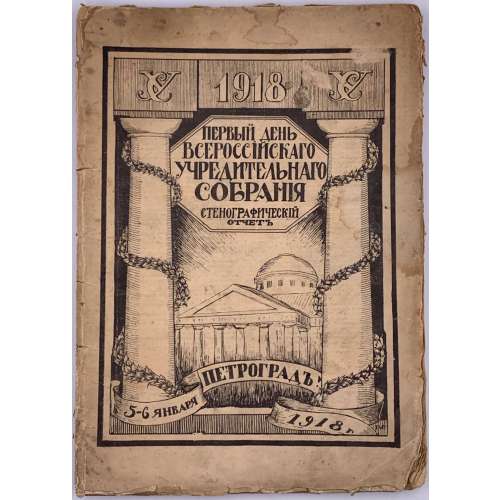 Cover: УС 1918 УС | ПЕРВЫЙ ДЕНЬ | ВСЕРОССIЙСКАГО | УЧРЕДИТЕЛЬНАГО | СОБРАНIЯ | СТЕНОГРАФИЧЕСКIЙ | ОТЧЕТЪ | 5-6 ЯНВАРЯ […] ПЕТРОГРАДЪ […] 1918 г. Title page: УЧРЕДИТЕЛЬНОЕ | СОБРАНIЕ | СТЕНОГРАФИЧЕСКIЙ ОТЧЕТЪ | ПЕЧАТАЕТСЯ ПО РАСПОРЯЖЕНIЮ ПРЕДСѢДАТЕЛЯ | УЧРЕДИТЕЛЬНАГО СОБРАНIЯ. | ПЕТРОГРАДЪ | Пятая Государственная типография, Стремянная, 12. | 1918. || Pencil inscription to t.p.: "Москва 1923 г. С. Варшавский". 23 x 16.5 cm, publisher’s pictorial wrappers, woodcut to front cover, pp.: [1-3] 4-112; collation: [1]8 2-78.
Cover: УС 1918 УС | ПЕРВЫЙ ДЕНЬ | ВСЕРОССIЙСКАГО | УЧРЕДИТЕЛЬНАГО | СОБРАНIЯ | СТЕНОГРАФИЧЕСКIЙ | ОТЧЕТЪ | 5-6 ЯНВАРЯ […] ПЕТРОГРАДЪ […] 1918 г. Title page: УЧРЕДИТЕЛЬНОЕ | СОБРАНIЕ | СТЕНОГРАФИЧЕСКIЙ ОТЧЕТЪ | ПЕЧАТАЕТСЯ ПО РАСПОРЯЖЕНIЮ ПРЕДСѢДАТЕЛЯ | УЧРЕДИТЕЛЬНАГО СОБРАНIЯ. | ПЕТРОГРАДЪ | Пятая Государственная типография, Стремянная, 12. | 1918. || Pencil inscription to t.p.: "Москва 1923 г. С. Варшавский". 23 x 16.5 cm, publisher’s pictorial wrappers, woodcut to front cover, pp.: [1-3] 4-112; collation: [1]8 2-78. -
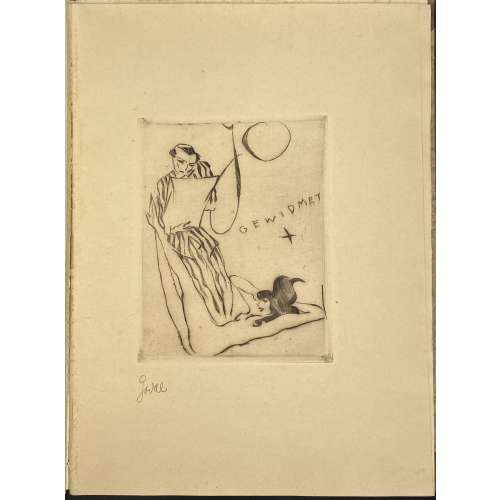 Half calf binding 33.5 x 25 cm, gilt lettering within rules “GODAL | JO”, engraved title-page and 9 etchings printed in sepia on sheets 32.5 x 24 cm of thick wove paper, pencil signed, presumably, by the artist; a newspaper clipping tipped-in. The number of copies is unknown. Ticket to front pastedown: "Haeusgen |8 München 90 | Reinekestrasse 36" According to seller: “Extraordinarily rare series of erotic original etchings. - Cf. Bilderlexikon II, 451 u. Vollmer II, 261 - According to KVK not in any library”. Contributors: Erich Godal [Erich Goldbaum] (German-Jewish, 1899 – 1969) – artist.
Half calf binding 33.5 x 25 cm, gilt lettering within rules “GODAL | JO”, engraved title-page and 9 etchings printed in sepia on sheets 32.5 x 24 cm of thick wove paper, pencil signed, presumably, by the artist; a newspaper clipping tipped-in. The number of copies is unknown. Ticket to front pastedown: "Haeusgen |8 München 90 | Reinekestrasse 36" According to seller: “Extraordinarily rare series of erotic original etchings. - Cf. Bilderlexikon II, 451 u. Vollmer II, 261 - According to KVK not in any library”. Contributors: Erich Godal [Erich Goldbaum] (German-Jewish, 1899 – 1969) – artist. -
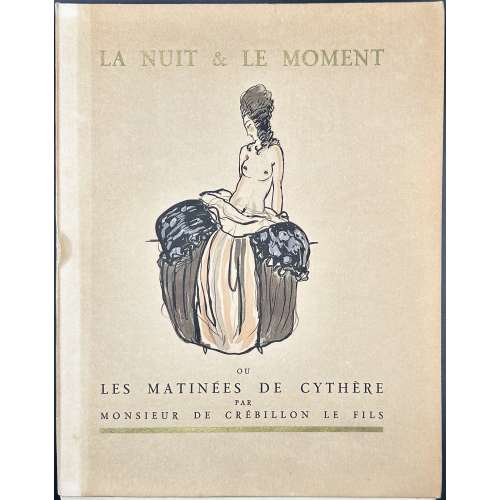 Softcover volume, 33 x 26 cm, collated in folio, not bound, in publisher’s French flapped pictorial wrappers, lettering to spine; printed on thick wove Arches paper watermarked “MBM”, upper edge trimmed, owner’s blind stamp to h.t. “Ex Libris Comte Tony de Vibraye”, glassine dust jacket, in a slipcase. Collation: π2 1-262, total 54 leaves, plus 4 leaves in wrappers, plus 10 plates, incl. frontispiece; coloured aquatints after Sylvain Sauvage; coloured etched vignette to front wrapper, gilt woodcut to back wrapper, woodcut title-page and woodcut headpiece after the same. Pp.: [4] [1] 2-102 [2]. Front wrapper (gilt and black): LA NUIT & LE MOMENT | {vignette} | OU | LES MATINÉES DE CYTHÈRE | PAR | MONSIEUR DE CRÉBILLON LE FILS | — || Title-page (woodcut): CRÉBILLON LE FILS | — | LA NUIT ET LE MOMENT | OU | LES MATINÉES | DE CYTHÈRE | {vignette} | A PARIS | AUX DEPENS D'UN AMATEUR | — | M CM XXIV || Limitation: De cette édition il a été tiré un exemplaire unique sur japon impérial comportant dix aquarelles originales, deux cents trente exemplaires sur vélin d' Arches numérotés 1 à 230, dont les dix premiers avec une suite de hors texte sur japon. N° 1 [Print run limited to 230 copies on Arches plus a unique copy on Japon with original watercolours, this is copy № 1 on wove paper]. Seller’s description: La Nuit et le moment ou Les Matinées de Cythère. Paris, Au dépens d'un amateur, 1924. In-4, en feuilles, non rogné, couverture illustrée et étui. Ouvrage illustré de 4 gravures sur bois et de 10 eaux-fortes libres en couleurs hors texte de Sylvain Sauvage. Tirage à 231 exemplaires, celui-ci le n°1 sur vélin d'Arches. Manque la suite de hors texte sur japon. De la bibliothèque du Comte Tony de Vibraye, avec cachet à froid. Dutel, n°2062. Catalogue raisonné: honesterotica.com; Dutel III 2062. Contributors: Claude-Prosper Jolyot de Crébillon [Crébillon fils] (French, 1707 – 1777) – author. Sylvain Sauvage [Félix Roy] (French, 1888 – 1948) – artist. Provenance: Antoine Henri Gaston Hurault de Vibraye [Comte Tony de Vibraye] (French, 1893 – 1951)
Softcover volume, 33 x 26 cm, collated in folio, not bound, in publisher’s French flapped pictorial wrappers, lettering to spine; printed on thick wove Arches paper watermarked “MBM”, upper edge trimmed, owner’s blind stamp to h.t. “Ex Libris Comte Tony de Vibraye”, glassine dust jacket, in a slipcase. Collation: π2 1-262, total 54 leaves, plus 4 leaves in wrappers, plus 10 plates, incl. frontispiece; coloured aquatints after Sylvain Sauvage; coloured etched vignette to front wrapper, gilt woodcut to back wrapper, woodcut title-page and woodcut headpiece after the same. Pp.: [4] [1] 2-102 [2]. Front wrapper (gilt and black): LA NUIT & LE MOMENT | {vignette} | OU | LES MATINÉES DE CYTHÈRE | PAR | MONSIEUR DE CRÉBILLON LE FILS | — || Title-page (woodcut): CRÉBILLON LE FILS | — | LA NUIT ET LE MOMENT | OU | LES MATINÉES | DE CYTHÈRE | {vignette} | A PARIS | AUX DEPENS D'UN AMATEUR | — | M CM XXIV || Limitation: De cette édition il a été tiré un exemplaire unique sur japon impérial comportant dix aquarelles originales, deux cents trente exemplaires sur vélin d' Arches numérotés 1 à 230, dont les dix premiers avec une suite de hors texte sur japon. N° 1 [Print run limited to 230 copies on Arches plus a unique copy on Japon with original watercolours, this is copy № 1 on wove paper]. Seller’s description: La Nuit et le moment ou Les Matinées de Cythère. Paris, Au dépens d'un amateur, 1924. In-4, en feuilles, non rogné, couverture illustrée et étui. Ouvrage illustré de 4 gravures sur bois et de 10 eaux-fortes libres en couleurs hors texte de Sylvain Sauvage. Tirage à 231 exemplaires, celui-ci le n°1 sur vélin d'Arches. Manque la suite de hors texte sur japon. De la bibliothèque du Comte Tony de Vibraye, avec cachet à froid. Dutel, n°2062. Catalogue raisonné: honesterotica.com; Dutel III 2062. Contributors: Claude-Prosper Jolyot de Crébillon [Crébillon fils] (French, 1707 – 1777) – author. Sylvain Sauvage [Félix Roy] (French, 1888 – 1948) – artist. Provenance: Antoine Henri Gaston Hurault de Vibraye [Comte Tony de Vibraye] (French, 1893 – 1951) -
![Э. Лиссагарэ. История Парижской Коммуны в 1871 году / С французского. Полный перевод под редакцией В. Базарова. — С.-Петербург. 1906. (Дешевая библиотека товарищества "Знание", № 274). — pp.:[4] [1] 2-524. [Проспер Оливье Лиссагарэ].](https://varshavskycollection.com/wp-content/uploads/2021/02/LIB-1158.2016-d-500x500.jpeg) Hardcover volume, collated in-8o, 21.1 x 14.9 cm, bound in half black polished morocco over green buckram boards, gilt lettering in rules to flat spine, brown diaper over cream endpapers, red ink oval library stamp in Estonian to t.p. «AJALOOMUUSEUM RAAMATUKOGU» (history museum library); pp.: [4] [1] 2-524, total 528 pages; collation π2 1-328 336, total 264 leaves. Title-page: ДЕШЕВАЯ БИБЛIОТЕКА ТОВАРИЩЕСТВА "ЗНАНIЕ". | № 274. | Э. Лиссагарэ. | ИСТОРIЯ ПАРИЖСКОЙ КОММУНЫ | въ 1871 г. | Съ французскаго. Полный переводъ | подъ редакцiей В. Базарова.| С.-ПЕТЕРБУРГЪ | 1906. || Original title: Prosper-Olivier Lissagaray. Histoire de la Commune de 1871. — Paris: E. Dentu, 1876. English translation by Eleanor Marx Aveling: [LIB-1110.2016] Prosper-Olivier Lissagaray. History of the Commune of 1871. — London: Reeves and Turner, 1886. Contributors: Hippolyte Prosper-Olivier Lissagaray (French, 1838 – 1901) – author. Владимир Александрович Базаров [Руднев, Vladimir Bazarov] (Russian, 1874 – 1939) – translator.
Hardcover volume, collated in-8o, 21.1 x 14.9 cm, bound in half black polished morocco over green buckram boards, gilt lettering in rules to flat spine, brown diaper over cream endpapers, red ink oval library stamp in Estonian to t.p. «AJALOOMUUSEUM RAAMATUKOGU» (history museum library); pp.: [4] [1] 2-524, total 528 pages; collation π2 1-328 336, total 264 leaves. Title-page: ДЕШЕВАЯ БИБЛIОТЕКА ТОВАРИЩЕСТВА "ЗНАНIЕ". | № 274. | Э. Лиссагарэ. | ИСТОРIЯ ПАРИЖСКОЙ КОММУНЫ | въ 1871 г. | Съ французскаго. Полный переводъ | подъ редакцiей В. Базарова.| С.-ПЕТЕРБУРГЪ | 1906. || Original title: Prosper-Olivier Lissagaray. Histoire de la Commune de 1871. — Paris: E. Dentu, 1876. English translation by Eleanor Marx Aveling: [LIB-1110.2016] Prosper-Olivier Lissagaray. History of the Commune of 1871. — London: Reeves and Turner, 1886. Contributors: Hippolyte Prosper-Olivier Lissagaray (French, 1838 – 1901) – author. Владимир Александрович Базаров [Руднев, Vladimir Bazarov] (Russian, 1874 – 1939) – translator. -
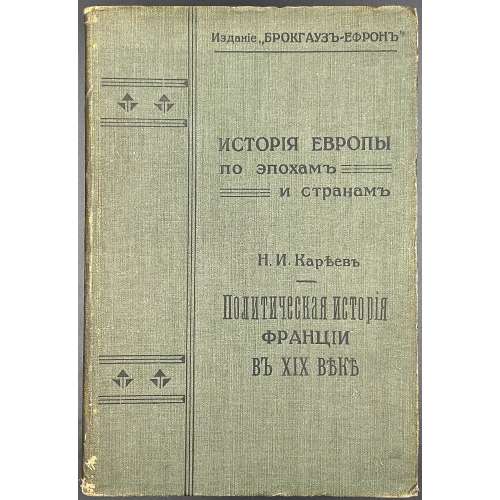 Cover: Изданiе "БРОКГАУЗЪ-ЕФРОНЪ" | ИСТОРIЯ ЕВРОПЫ | ПО ЭПОХАМЪ | И СТРАНАМЪ | Н. И. Карѣевъ | ПОЛИТИЧЕСКАЯ ИСТОРIЯ | ФРАНЦIИ | ВЪ XIX ВѢКѢ || Title page: Исторiя Европы по эпохамъ и странамъ в среднiе вѣка и новое время. | Изд. под. ред. Н. И. Карѣева и И. В. Лучицкаго. | Н. И. КАРѢЕВЪ | ПОЛИТИЧЕСКАЯ | ИСТОРIЯ ФРАНЦIИ | ВЪ XIX ВѢКѢ. | (Правительственныя формы и внутренняя политика, политическiя партiи | и общественные классы). | Изданiе Акц. Общ. "Брокгаузъ-Ефронъ". | С.-ПЕТЕРБУРГЪ. | Типографiя Акц. Общ. Брокгаузъ-Ефронъ. Прачешный пер. № 6. | 1902. || Pagination: [2] – title / blank, [i-iii] iv-v [vi], [1] 2-300 +1 colour plate (maps). Collation: 8vo; [π]4 1-188 196 + 1 leaf (maps). Binding: Publisher’s green cloth with black lettering to spine and cover, design elements to cover. Contributors: Кареев, Николай Иванович (Russian, 1850 – 1931) – author.
Cover: Изданiе "БРОКГАУЗЪ-ЕФРОНЪ" | ИСТОРIЯ ЕВРОПЫ | ПО ЭПОХАМЪ | И СТРАНАМЪ | Н. И. Карѣевъ | ПОЛИТИЧЕСКАЯ ИСТОРIЯ | ФРАНЦIИ | ВЪ XIX ВѢКѢ || Title page: Исторiя Европы по эпохамъ и странамъ в среднiе вѣка и новое время. | Изд. под. ред. Н. И. Карѣева и И. В. Лучицкаго. | Н. И. КАРѢЕВЪ | ПОЛИТИЧЕСКАЯ | ИСТОРIЯ ФРАНЦIИ | ВЪ XIX ВѢКѢ. | (Правительственныя формы и внутренняя политика, политическiя партiи | и общественные классы). | Изданiе Акц. Общ. "Брокгаузъ-Ефронъ". | С.-ПЕТЕРБУРГЪ. | Типографiя Акц. Общ. Брокгаузъ-Ефронъ. Прачешный пер. № 6. | 1902. || Pagination: [2] – title / blank, [i-iii] iv-v [vi], [1] 2-300 +1 colour plate (maps). Collation: 8vo; [π]4 1-188 196 + 1 leaf (maps). Binding: Publisher’s green cloth with black lettering to spine and cover, design elements to cover. Contributors: Кареев, Николай Иванович (Russian, 1850 – 1931) – author. -
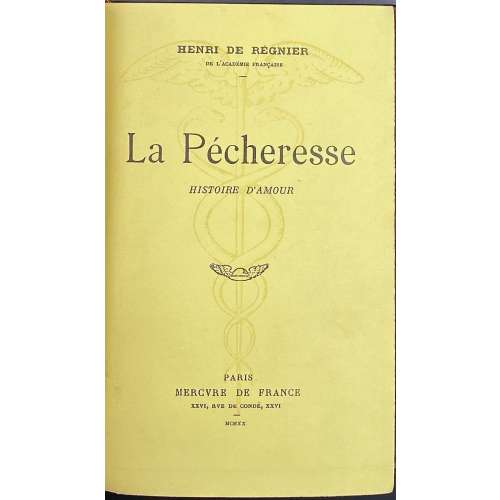 Hardcover volume, 19 x 13 cm, collated in-12mo, bound by Henri Creuzevault (signed) in full crushed brown morocco, spine with raised bands, gilt lettering “H. DE RÉGNIER | – | LA PÉCHERESSE” and “PARIS 1920” in the bottom compartment; gilt fillet to cover margin, five gilt fillets inside, marbled endpapers, bookplate of J.-P. Dutel to flyleaf, original yellow publisher’s wrappers preserved, top edge gilt, in a marbled slipcase; printed on dense wove paper (Japon). Inset: Receipt from Librairie ancienne et modern – Georges Venot (Lyon), dated April 16, 1938. Title-page / Cover: HENRI DE RÉGNIER | DE L’ACADÉMIE FRANÇAISE | – | La Pécheresse | HISTOIRE D’AMOUR | {publisher’s device} | PARIS | MERCVRE DE France | XXVI, RVE DE CONDÉ, XXVI | MCMXX || Limitation: 158 copies on Japon (№№ 1-158), 95 copies on Chine (№№ 159-253), 515 copies on Hollande (№№ 254-768), 1,650 copies on vélin pur fil de Lafuma (№№ 769-2393, and 25 copies not for sale marked A-Z. This is № 75 (on Japon), a unique copy enriched with 7 original watercolours by Serge de Solomko. Collation: 3 blank flyleaves, front wrapper, π6 (1 h.t./advert., 1 t.p./limit., 1 dedication, 3), 1-206, 212, back wrapper, spine, 3 blank flyleaves, list of illustrations pasted to recto endpaper “La Pécheresse. | 7 aquarelles de Solemko (sic.) | 57, 64, 168, 256, 289, 320, 346”, seven plates bound in as per the list. Pagination: [1-5] 6-350, ils. OCLC Number / Unique Identifier: 715077259. Contributors: Henri de Régnier (French, 1864 – 1936) – author. Auguste Gilbert de Voisins (1877 – 1939) – dedicatee. Sergueï Solomko [Сергей Сергеевич Соломко, Serge de Solomko] (Russian-French, 1867 – 1928) – artist. Henri Creuzevault (French, 1905 – 1971) – bookbinder. J.-P. Dutel description: RÉGNIER, Henri de. LA PECHERESSE. Paris, Mercure de France, 1920. In-12 (18,3 x 11,4 cm) de [1] f., 350 pp., maroquin janséniste grenat, dos à 5 nerfs, filets dorés intérieurs, tête dorée, filets dorés sur les coupes, non rogné, couverture et dos conservés, étui bordé. (Creuzevault). ÉDITION ORIGINALE. Tirage : 95 ex. sur chine. 158 ex. sur japon. 515 ex. sur hollande. UN DES 158 EXEMPLAIRES SUR JAPON. EXEMPLAIRE UNIQUE ENRICHI DE 7 AQUARELLES ORIGINALES HORS-TEXTE SIGNÉES PAR SERGE DE SOLOMKO. Sergueï Sergueïevitch Solomko « Serge de Solomko », (Saint-Petersburg, 1867- Sainte Geneviève des bois, 1928) est un illustrateur, graphiste et aquarelliste russe qui vécut en partie en France. Qualifiée d'histoire d'amour, cette œuvre d'Henri de Régnier est dédiée à Gilbert de Voisins, poète et romancier, en témoignage de fraternelle amitié. Elle est placée par son auteur sous les auspices du moraliste et critique libertin Saint-Evremond dont une citation figure en exergue du livre : « Il y a des temps où l'on pleure les plaisirs perdus, des temps où l'on pleure les péchés commis. » Et l'auteur d'incipiter comme suit : « J'ai toujours été si curieux des particularités que l'on découvre au caractère des femmes que, pas une fois, je n'ai négligé de m'instruire sur le sujet. » « (...) le point où se montre le mieux et le plus ouvertement ce que la nature les a faites, est celui de l'amour. »
Hardcover volume, 19 x 13 cm, collated in-12mo, bound by Henri Creuzevault (signed) in full crushed brown morocco, spine with raised bands, gilt lettering “H. DE RÉGNIER | – | LA PÉCHERESSE” and “PARIS 1920” in the bottom compartment; gilt fillet to cover margin, five gilt fillets inside, marbled endpapers, bookplate of J.-P. Dutel to flyleaf, original yellow publisher’s wrappers preserved, top edge gilt, in a marbled slipcase; printed on dense wove paper (Japon). Inset: Receipt from Librairie ancienne et modern – Georges Venot (Lyon), dated April 16, 1938. Title-page / Cover: HENRI DE RÉGNIER | DE L’ACADÉMIE FRANÇAISE | – | La Pécheresse | HISTOIRE D’AMOUR | {publisher’s device} | PARIS | MERCVRE DE France | XXVI, RVE DE CONDÉ, XXVI | MCMXX || Limitation: 158 copies on Japon (№№ 1-158), 95 copies on Chine (№№ 159-253), 515 copies on Hollande (№№ 254-768), 1,650 copies on vélin pur fil de Lafuma (№№ 769-2393, and 25 copies not for sale marked A-Z. This is № 75 (on Japon), a unique copy enriched with 7 original watercolours by Serge de Solomko. Collation: 3 blank flyleaves, front wrapper, π6 (1 h.t./advert., 1 t.p./limit., 1 dedication, 3), 1-206, 212, back wrapper, spine, 3 blank flyleaves, list of illustrations pasted to recto endpaper “La Pécheresse. | 7 aquarelles de Solemko (sic.) | 57, 64, 168, 256, 289, 320, 346”, seven plates bound in as per the list. Pagination: [1-5] 6-350, ils. OCLC Number / Unique Identifier: 715077259. Contributors: Henri de Régnier (French, 1864 – 1936) – author. Auguste Gilbert de Voisins (1877 – 1939) – dedicatee. Sergueï Solomko [Сергей Сергеевич Соломко, Serge de Solomko] (Russian-French, 1867 – 1928) – artist. Henri Creuzevault (French, 1905 – 1971) – bookbinder. J.-P. Dutel description: RÉGNIER, Henri de. LA PECHERESSE. Paris, Mercure de France, 1920. In-12 (18,3 x 11,4 cm) de [1] f., 350 pp., maroquin janséniste grenat, dos à 5 nerfs, filets dorés intérieurs, tête dorée, filets dorés sur les coupes, non rogné, couverture et dos conservés, étui bordé. (Creuzevault). ÉDITION ORIGINALE. Tirage : 95 ex. sur chine. 158 ex. sur japon. 515 ex. sur hollande. UN DES 158 EXEMPLAIRES SUR JAPON. EXEMPLAIRE UNIQUE ENRICHI DE 7 AQUARELLES ORIGINALES HORS-TEXTE SIGNÉES PAR SERGE DE SOLOMKO. Sergueï Sergueïevitch Solomko « Serge de Solomko », (Saint-Petersburg, 1867- Sainte Geneviève des bois, 1928) est un illustrateur, graphiste et aquarelliste russe qui vécut en partie en France. Qualifiée d'histoire d'amour, cette œuvre d'Henri de Régnier est dédiée à Gilbert de Voisins, poète et romancier, en témoignage de fraternelle amitié. Elle est placée par son auteur sous les auspices du moraliste et critique libertin Saint-Evremond dont une citation figure en exergue du livre : « Il y a des temps où l'on pleure les plaisirs perdus, des temps où l'on pleure les péchés commis. » Et l'auteur d'incipiter comme suit : « J'ai toujours été si curieux des particularités que l'on découvre au caractère des femmes que, pas une fois, je n'ai négligé de m'instruire sur le sujet. » « (...) le point où se montre le mieux et le plus ouvertement ce que la nature les a faites, est celui de l'amour. » -
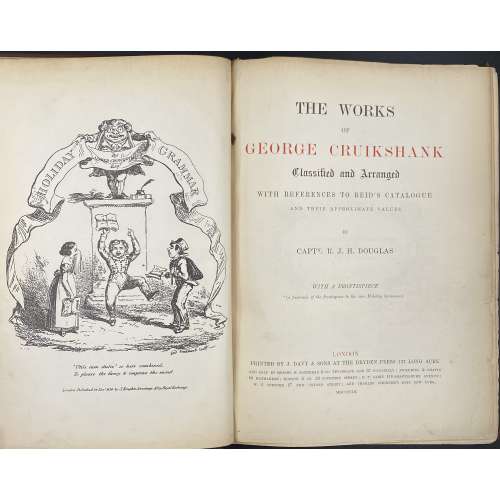 Half-title: THE WORKS | OF | GEORGE CRUIKSHANK | CLASSIFIED AND ARRANGED.|| Title: (in black and red) THE WORKS | OF | GEORGE CRUIKSHANK | CLASSIFIED AND ARRANGED | WITH REFERENCES TO REID'S CATALOGUE | AND THEIR APPROXIMATE VALUES| BY | CAPTN. R. J. H. DOUGLAS | WITH A FRONTISPIECE | (a facsimile of the frontispiece to the rare Holiday Grammar) | LONDON | PRINTED BY J. DAVY & SONS AT THE DRYDEN PRESS 137 LONG ACRE | AND SOLD BY MESSRS. H. SOTHERAN & CO. 140 STRAND AND 37 PICADILLY ; PICKERING & CATTO | 66 HAYMARKET ; ROBSON & CO 23 COVENTRY STREET ; F. T. SABIN 118 SHAFTESBURY AVENUE ; | W. T. SPENSER 27 NEW OXFORD STREET ; AND CHARLES SCRIBNER’S SONS NEW YORK. | MDCCCCIII || Imprint (title verso): One Thousand Copies of this book have been printed and the type distributed. This is No. 205. Bookplate to recto ffl: Reference Library of Francis Edwards Ltd. Not for sale. Inscription to recto ffl: “With the author’s compliments”. Pagination: ffl, [i, ii] – h.t. / blank, [2] – blank / frontis., [iii, iv] – t.p. (black and red) / Print run, [v] v-vi –preface, [2] – contents, [2] – f.t. / note; [1] 2-301 [302] – colophon; insert one sheet with type writing on Francis Edwards letterhead, bfl. (OCLC: ix, 302 pages : illustrations ; 26 cm) Collation: [A]5 B-T8 U7 Binding: Hardcover, burgundy cloth gilt-stamped with title and publisher’s device to front board and gilt lettering to spine.
Half-title: THE WORKS | OF | GEORGE CRUIKSHANK | CLASSIFIED AND ARRANGED.|| Title: (in black and red) THE WORKS | OF | GEORGE CRUIKSHANK | CLASSIFIED AND ARRANGED | WITH REFERENCES TO REID'S CATALOGUE | AND THEIR APPROXIMATE VALUES| BY | CAPTN. R. J. H. DOUGLAS | WITH A FRONTISPIECE | (a facsimile of the frontispiece to the rare Holiday Grammar) | LONDON | PRINTED BY J. DAVY & SONS AT THE DRYDEN PRESS 137 LONG ACRE | AND SOLD BY MESSRS. H. SOTHERAN & CO. 140 STRAND AND 37 PICADILLY ; PICKERING & CATTO | 66 HAYMARKET ; ROBSON & CO 23 COVENTRY STREET ; F. T. SABIN 118 SHAFTESBURY AVENUE ; | W. T. SPENSER 27 NEW OXFORD STREET ; AND CHARLES SCRIBNER’S SONS NEW YORK. | MDCCCCIII || Imprint (title verso): One Thousand Copies of this book have been printed and the type distributed. This is No. 205. Bookplate to recto ffl: Reference Library of Francis Edwards Ltd. Not for sale. Inscription to recto ffl: “With the author’s compliments”. Pagination: ffl, [i, ii] – h.t. / blank, [2] – blank / frontis., [iii, iv] – t.p. (black and red) / Print run, [v] v-vi –preface, [2] – contents, [2] – f.t. / note; [1] 2-301 [302] – colophon; insert one sheet with type writing on Francis Edwards letterhead, bfl. (OCLC: ix, 302 pages : illustrations ; 26 cm) Collation: [A]5 B-T8 U7 Binding: Hardcover, burgundy cloth gilt-stamped with title and publisher’s device to front board and gilt lettering to spine. -
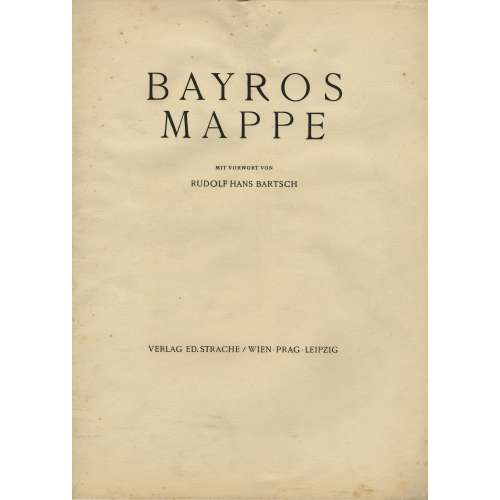 An album 45 of 50 prints, 31 photogravures and 14 in raster chromotype after drawings and paintings by Franz von Bayros; most with tissue guards, some in passepartout; colour prints mounted on the same paper that is used for photogravures. Title-page: BAYROS | MAPPE | MIT VORWORT VON | RUDOLF HANS BARTSCH | VERLAG ED. STRACHE / WIEN • PRAG • LEIPZIG || Limited edition of 500 copies. This is copy № 286. Lacking 5 prints: (1) Abschied vom Paradies, (2) Weihnacht, and (3) Harmonie from Symphonie von der Gūte, die Schönheit ist; (4) Divina commedia from Florentiner Phantasien; and (5) Mozart from Varia. Contributors: Franz von Bayros (Austrian, 1866 – 1924) Rudolf Hans Bartsch (Austrian, 1873 – 1952)
An album 45 of 50 prints, 31 photogravures and 14 in raster chromotype after drawings and paintings by Franz von Bayros; most with tissue guards, some in passepartout; colour prints mounted on the same paper that is used for photogravures. Title-page: BAYROS | MAPPE | MIT VORWORT VON | RUDOLF HANS BARTSCH | VERLAG ED. STRACHE / WIEN • PRAG • LEIPZIG || Limited edition of 500 copies. This is copy № 286. Lacking 5 prints: (1) Abschied vom Paradies, (2) Weihnacht, and (3) Harmonie from Symphonie von der Gūte, die Schönheit ist; (4) Divina commedia from Florentiner Phantasien; and (5) Mozart from Varia. Contributors: Franz von Bayros (Austrian, 1866 – 1924) Rudolf Hans Bartsch (Austrian, 1873 – 1952) -
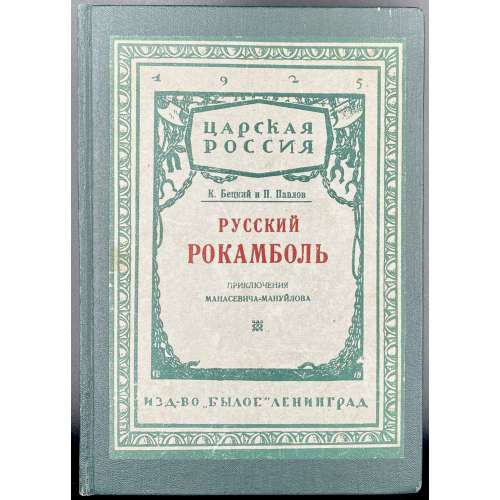 Hardcover, 20 x 14 cm, owner’s later green buckram with the original wrapper pasted to front board: wood engraving printed in green (egg and dart border with “1925” on top and “ИЗД-ВО «БЫЛОЕ» ЛЕНИНГРАД” in the bottom, inside the border a pictorial frame, depicting chains, manacles, and axes with red and green lettering inside: “ЦАРСКАЯ РОССИЯ (framed) | РУССКИЙ | РОКАМБОЛЬ | ПРИКЛЮЧЕНИЯ | МАНАСЕВИЧА-МАНУЙЛОВА | {fleuron}”; in the bottom corners of the frame monogrammed letters “В” and “Б”, for Вениамин Белкин (Veniamin Belkin). Pagination: [1-4] 5-239 [240]; collated 8vo: [1]-158, total 120 leaves. Title-page: — | К. Бецкий и П. Павлов | РУССКИЙ РОКАМБОЛЬ | (ПРИКЛЮЧЕНИЯ И. Ф. МАНАСЕВИЧА-МАНУЙЛОВА) | — | ИЗДАТЕЛЬСТВО «БЫЛОЕ» | ЛЕНИНГРАД • 1925 || Print run: 5,000 copies. Contributors: Вениамин Павлович Белкин [Veniamin Belkin] (Russian, 1884 – 1951) – artist of the cover. К. Бецкий (pseudonym), real name Иосиф Яковлевич Кобецкий (Jewish-Russian, ? – ?) – author. П. Павлов (pseudonym), real name Павел Елисеевич Щеголев (Russian, 1877 – 1931) – author. Иван Фёдорович Манасевич-Мануйлов [Исаак Тодресович Манасевич, Ivan Manassievitch-Manouïlov] (Jewish-Russian, 1869/71—1918) – character.
Hardcover, 20 x 14 cm, owner’s later green buckram with the original wrapper pasted to front board: wood engraving printed in green (egg and dart border with “1925” on top and “ИЗД-ВО «БЫЛОЕ» ЛЕНИНГРАД” in the bottom, inside the border a pictorial frame, depicting chains, manacles, and axes with red and green lettering inside: “ЦАРСКАЯ РОССИЯ (framed) | РУССКИЙ | РОКАМБОЛЬ | ПРИКЛЮЧЕНИЯ | МАНАСЕВИЧА-МАНУЙЛОВА | {fleuron}”; in the bottom corners of the frame monogrammed letters “В” and “Б”, for Вениамин Белкин (Veniamin Belkin). Pagination: [1-4] 5-239 [240]; collated 8vo: [1]-158, total 120 leaves. Title-page: — | К. Бецкий и П. Павлов | РУССКИЙ РОКАМБОЛЬ | (ПРИКЛЮЧЕНИЯ И. Ф. МАНАСЕВИЧА-МАНУЙЛОВА) | — | ИЗДАТЕЛЬСТВО «БЫЛОЕ» | ЛЕНИНГРАД • 1925 || Print run: 5,000 copies. Contributors: Вениамин Павлович Белкин [Veniamin Belkin] (Russian, 1884 – 1951) – artist of the cover. К. Бецкий (pseudonym), real name Иосиф Яковлевич Кобецкий (Jewish-Russian, ? – ?) – author. П. Павлов (pseudonym), real name Павел Елисеевич Щеголев (Russian, 1877 – 1931) – author. Иван Фёдорович Манасевич-Мануйлов [Исаак Тодресович Манасевич, Ivan Manassievitch-Manouïlov] (Jewish-Russian, 1869/71—1918) – character. -
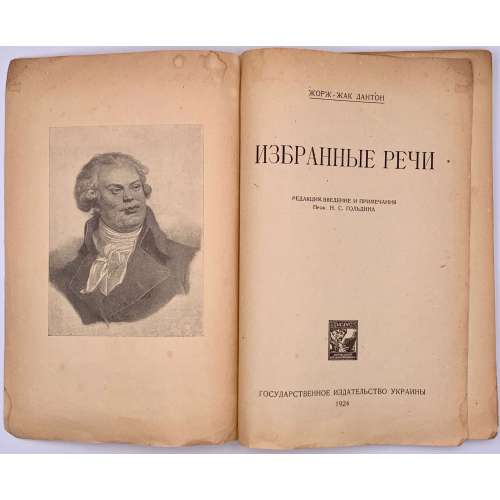 Title page: ЖОРЖ-ЖАК ДАНТОН | ИЗБРАННЫЕ РЕЧИ | РЕДАКЦИЯ, ВВЕДЕНИЕ И ПРИМЕЧАНИЯ | Проф. Н. С. ГОЛЬДИНА | {publisher’s device} | ГОСУДАРСТВЕННОЕ ИЗДАТЕЛЬСТВО УКРАИНЫ | 1924 Lacking wrappers, [2] – blank / frontispiece portrait of Danton, [2] t.p., / imprint, v-xviii, [2] –f.t / blank, 1-111 [112], collation: π2 *8 1-78. Danton, Georges Jacques [Дантон, Жорж Жак] (French, 1759 – 1794). Гольдин, Николай Сергеевич (Ukrainian-Jewish, 1877 – after 1924). Translator unknown.
Title page: ЖОРЖ-ЖАК ДАНТОН | ИЗБРАННЫЕ РЕЧИ | РЕДАКЦИЯ, ВВЕДЕНИЕ И ПРИМЕЧАНИЯ | Проф. Н. С. ГОЛЬДИНА | {publisher’s device} | ГОСУДАРСТВЕННОЕ ИЗДАТЕЛЬСТВО УКРАИНЫ | 1924 Lacking wrappers, [2] – blank / frontispiece portrait of Danton, [2] t.p., / imprint, v-xviii, [2] –f.t / blank, 1-111 [112], collation: π2 *8 1-78. Danton, Georges Jacques [Дантон, Жорж Жак] (French, 1759 – 1794). Гольдин, Николай Сергеевич (Ukrainian-Jewish, 1877 – after 1924). Translator unknown. -
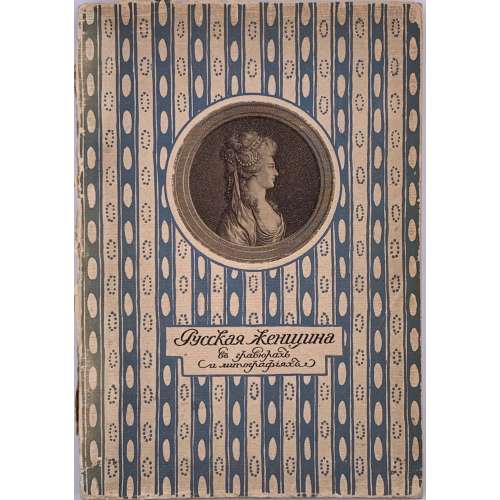 Description: Softcover volume in publisher’s pictorial wrappers, with a b/w medallion portrait and lettering in a frame over geometrical pattern in blue to front; 23 x 16.3 cm, collated 8vo. Title-page: РУССКАЯ ЖЕНЩИНА | ВЪ | ГРАВЮРАХЪ И ЛИТОГРАФIЯХЪ | – | ВЫСТАВКА ПОРТРЕТОВЪ | – | КРУЖОКЪ ЛЮБИТЕЛЕЙ | РУССКИХЪ ИЗЯЩНЫХЪ ИЗДАНIЙ | 1911 || Collation: 1-48, last blank, total 32 leaves plus 15 plates (collotype reproductions) with tissue guards, incl. frontispiece, and a few headpieces; catalogue with 180 entries. Pagination: [1-6] 7-63 [64] [2], total 64 pages, ils. Incl. article "Русская женщина в искусстве" барона Н. Н. Врангеля. Барон Николай Николаевич Врангель (Russian, 1880 – 1915)
Description: Softcover volume in publisher’s pictorial wrappers, with a b/w medallion portrait and lettering in a frame over geometrical pattern in blue to front; 23 x 16.3 cm, collated 8vo. Title-page: РУССКАЯ ЖЕНЩИНА | ВЪ | ГРАВЮРАХЪ И ЛИТОГРАФIЯХЪ | – | ВЫСТАВКА ПОРТРЕТОВЪ | – | КРУЖОКЪ ЛЮБИТЕЛЕЙ | РУССКИХЪ ИЗЯЩНЫХЪ ИЗДАНIЙ | 1911 || Collation: 1-48, last blank, total 32 leaves plus 15 plates (collotype reproductions) with tissue guards, incl. frontispiece, and a few headpieces; catalogue with 180 entries. Pagination: [1-6] 7-63 [64] [2], total 64 pages, ils. Incl. article "Русская женщина в искусстве" барона Н. Н. Врангеля. Барон Николай Николаевич Врангель (Russian, 1880 – 1915) -
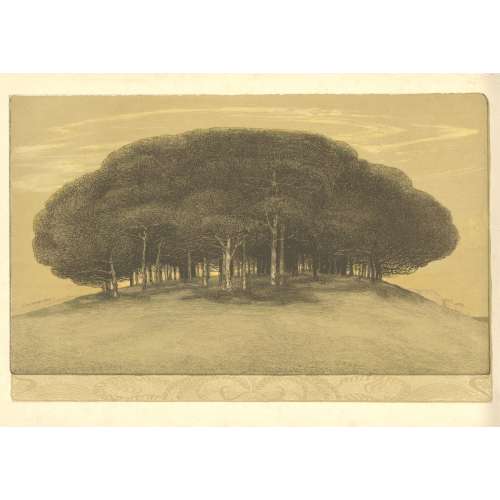 Colour (tone) lithography, image 268 x 410 mm, sheet 317 x 470 mm; signed on bottom-left of the image “Pelikan 1905”, and pencil ms inscription: E. Pelikan to the lower-right corner of the sheet. Contributor: Emilie Mediz-Pelikan (Austrian, 1861 – 1908) – artist. Seller's description: Austrian-German painter and graphic artist. Emilie Mediz-Pelikan was born in Vöcklabruck in 1861. She studied at the Vienna Academy and followed her teacher Albert Zimmermann to Salzburg and in 1885 to Munich. In 1891 she married the painter and graphic artist Karl Mediz (1868 - 1945), with whom she lived in Vienna and from 1894 in Dresden. She was in contact with the Dachau Artists' Colony and went on study trips to Paris, Belgium, Hungary and Italy. In the Dachau artists' colony she was friends with Adolf Hölzel and Fritz von Uhde. In 1889 and 1890 she spent time in Paris and in the Belgian artists' colony Knokke. In 1898 she was represented at the first art exhibition of the Vienna Secession, and in 1901 at the International Art Exhibition in Dresden. In 1903 she and her husband had a group exhibition, at the Hagenbund in Vienna. In 1904, she showed graphic works at the Dresden royal court art dealer Richter, and in 1905 and 1906 she exhibited at the Berlin Künstlerhaus. It was not until around 1900 that she achieved her artistic breakthrough with her landscape paintings. Since the estate of the artist, who died prematurely in Dresden in 1908, was lost in the former GDR until the 1980s, it was quite late that the artist was rediscovered and revalued both in Austrian art history and on the art market. In 1986, the first major exhibitions took place at the Upper Austrian State Museum and the University of Applied Arts in Vienna, followed by numerous smaller exhibitions in private galleries in Vienna, Linz and Munich. The artist received recognition during her lifetime from numerous prominent fellow painters as well as from the art critic Ludwig Hevesi. Together with Tina Blau, Herbert Boeckl, Marie Egner, Theodor von Hörmann, Franz Jaschke, Eugen Jettel, Ludwig Heinrich Jungnickel, Rudolf Junk, Gustav Klimt, Oskar Kokoschka, Johann Victor Krämer, Heinrich Kühn, Carl Moll, Rudolf Quittner, Rudolf Ribarz, Emil Jakob Schindler, Max Suppantschitsch, Max Weiler, Olga Wisinger-Florian and Alfred Zoff, she was a protagonist of the reception of Impressionism in Austria. This style went down in Austrian art history under the term "Stimmungsimpressionismus".
Colour (tone) lithography, image 268 x 410 mm, sheet 317 x 470 mm; signed on bottom-left of the image “Pelikan 1905”, and pencil ms inscription: E. Pelikan to the lower-right corner of the sheet. Contributor: Emilie Mediz-Pelikan (Austrian, 1861 – 1908) – artist. Seller's description: Austrian-German painter and graphic artist. Emilie Mediz-Pelikan was born in Vöcklabruck in 1861. She studied at the Vienna Academy and followed her teacher Albert Zimmermann to Salzburg and in 1885 to Munich. In 1891 she married the painter and graphic artist Karl Mediz (1868 - 1945), with whom she lived in Vienna and from 1894 in Dresden. She was in contact with the Dachau Artists' Colony and went on study trips to Paris, Belgium, Hungary and Italy. In the Dachau artists' colony she was friends with Adolf Hölzel and Fritz von Uhde. In 1889 and 1890 she spent time in Paris and in the Belgian artists' colony Knokke. In 1898 she was represented at the first art exhibition of the Vienna Secession, and in 1901 at the International Art Exhibition in Dresden. In 1903 she and her husband had a group exhibition, at the Hagenbund in Vienna. In 1904, she showed graphic works at the Dresden royal court art dealer Richter, and in 1905 and 1906 she exhibited at the Berlin Künstlerhaus. It was not until around 1900 that she achieved her artistic breakthrough with her landscape paintings. Since the estate of the artist, who died prematurely in Dresden in 1908, was lost in the former GDR until the 1980s, it was quite late that the artist was rediscovered and revalued both in Austrian art history and on the art market. In 1986, the first major exhibitions took place at the Upper Austrian State Museum and the University of Applied Arts in Vienna, followed by numerous smaller exhibitions in private galleries in Vienna, Linz and Munich. The artist received recognition during her lifetime from numerous prominent fellow painters as well as from the art critic Ludwig Hevesi. Together with Tina Blau, Herbert Boeckl, Marie Egner, Theodor von Hörmann, Franz Jaschke, Eugen Jettel, Ludwig Heinrich Jungnickel, Rudolf Junk, Gustav Klimt, Oskar Kokoschka, Johann Victor Krämer, Heinrich Kühn, Carl Moll, Rudolf Quittner, Rudolf Ribarz, Emil Jakob Schindler, Max Suppantschitsch, Max Weiler, Olga Wisinger-Florian and Alfred Zoff, she was a protagonist of the reception of Impressionism in Austria. This style went down in Austrian art history under the term "Stimmungsimpressionismus". -
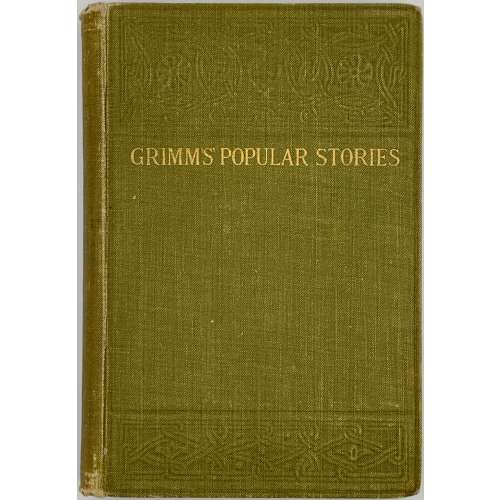 Title: OXFORD EDITION | POPULAR STORIES | COLLECTED BY | THE BROTHERS GRIMM | A REPRINT OF THE FIRST ENGLISH EDITION | WITH TWENTY-TWO ILLUSTRATIONS | BY GEORGE CRUIKSHANK | {publisher’s device} | HENRY FROWDE | LONDON, EDINBURGH, GLASGOW | NEW YORK AND TORONTO | 1905 || Pagination: [i, ii] – frontis., [iii-iv]– t.p. / imprint. [v] – preface, vi-xvii [xviii blank], [2] [1] 2-403 [404], plates included in pagination, pp. 379-403 – notes. Collation: a8 b2 B-Z8 Aa-Cc8 Dd2. Binding:1 9 x 13 cm, olive green cloth blind-stamped in art nouveau style and lettered in gilt to cover and spine: GRIMMS’ POPULAR STORIES. Aubergine pencil inscription to front pastedown: C. Grant Robertson | All Souls | 1905: Provenance: Sir Charles Grant Robertson CVO (British, 1869 – 1948) who was a British academic historian, a Fellow of All Souls College, Oxford, and Vice-chancellor of the University of Birmingham.
Title: OXFORD EDITION | POPULAR STORIES | COLLECTED BY | THE BROTHERS GRIMM | A REPRINT OF THE FIRST ENGLISH EDITION | WITH TWENTY-TWO ILLUSTRATIONS | BY GEORGE CRUIKSHANK | {publisher’s device} | HENRY FROWDE | LONDON, EDINBURGH, GLASGOW | NEW YORK AND TORONTO | 1905 || Pagination: [i, ii] – frontis., [iii-iv]– t.p. / imprint. [v] – preface, vi-xvii [xviii blank], [2] [1] 2-403 [404], plates included in pagination, pp. 379-403 – notes. Collation: a8 b2 B-Z8 Aa-Cc8 Dd2. Binding:1 9 x 13 cm, olive green cloth blind-stamped in art nouveau style and lettered in gilt to cover and spine: GRIMMS’ POPULAR STORIES. Aubergine pencil inscription to front pastedown: C. Grant Robertson | All Souls | 1905: Provenance: Sir Charles Grant Robertson CVO (British, 1869 – 1948) who was a British academic historian, a Fellow of All Souls College, Oxford, and Vice-chancellor of the University of Birmingham. -
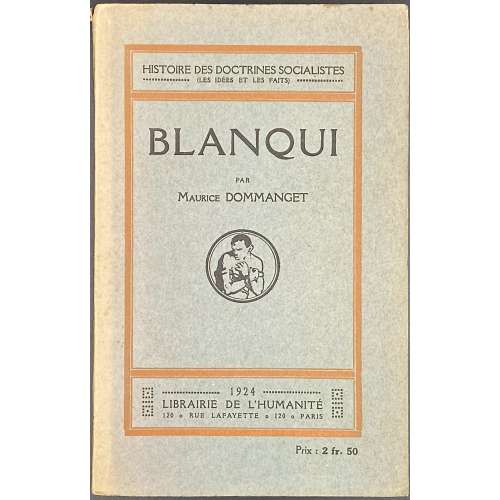 Front wrapper: In the three-compartment orange frame: 1st compartment: HISTOIRE DES DOCTRINES SOCIALISTES | *** (LES IDÉES ET LES FAITS) *** | 2nd compartment: BLANQUI | PAR | Maurice DOMMANGET | {circular device} | 3rd compartment: *** 1924 *** | LIBRAIRIE DE L'HUMANITÉ | 120 • RUE LAFAYETTE • 120 PARIS | Under the frame : Prix : 2 fr. 50 || Title page: HISTOIRE DES DOCTRINES SOCIALISTES | *** (LES IDÉES ET LES FAITS) *** | BLANQUI | PAR Maurice DOMMANGET | {device in a circle} | *** 1924 *** | LIBRAIRIE DE L'HUMANITÉ | 120 • RUE LAFAYETTE • 120 PARIS || Back wrapper: Advert. in an orange frame. Pagination: wrappers included in pagination ; [1-5] 6-95 [96-98] (total 49 leaves incl. wrappers). Collation: wrappers not included in collation: [1]-68. Binding: 18.5 x 12 cm; publisher’s blue wrappers with an orange frame, black lettering to covers and spine; uncut. Russian translation: LIB-2747.2021
Front wrapper: In the three-compartment orange frame: 1st compartment: HISTOIRE DES DOCTRINES SOCIALISTES | *** (LES IDÉES ET LES FAITS) *** | 2nd compartment: BLANQUI | PAR | Maurice DOMMANGET | {circular device} | 3rd compartment: *** 1924 *** | LIBRAIRIE DE L'HUMANITÉ | 120 • RUE LAFAYETTE • 120 PARIS | Under the frame : Prix : 2 fr. 50 || Title page: HISTOIRE DES DOCTRINES SOCIALISTES | *** (LES IDÉES ET LES FAITS) *** | BLANQUI | PAR Maurice DOMMANGET | {device in a circle} | *** 1924 *** | LIBRAIRIE DE L'HUMANITÉ | 120 • RUE LAFAYETTE • 120 PARIS || Back wrapper: Advert. in an orange frame. Pagination: wrappers included in pagination ; [1-5] 6-95 [96-98] (total 49 leaves incl. wrappers). Collation: wrappers not included in collation: [1]-68. Binding: 18.5 x 12 cm; publisher’s blue wrappers with an orange frame, black lettering to covers and spine; uncut. Russian translation: LIB-2747.2021 -
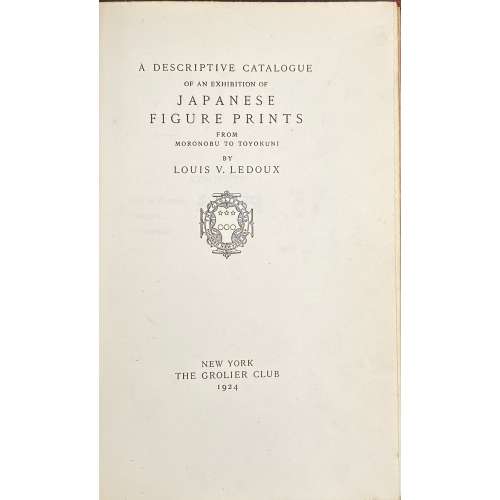 Hardcover, 24 x 16 cm, bound in quarter black calf over marbled boards, raised bands and gilt lettering to spine, printed on Van Gelder Zonen laid paper with wide margins, bottom and fore edge untrimmed, pp. [i-viii] ix-xiv, [2] 3-89 [90], total 104 pages, two flyleaves, frontispiece in colour with captioned tissue guard, and 28 b/w plates; total 83 leaves. Title-page: A DESCRIPTIVE CATALOGUE | OF AN EXHIBITION OF | JAPANESE | FIGURE PRINTS | FROM | MORONOBU TO TOYOKUNI | BY | LOUIS V. LEDOUX | {publisher’s device} | NEW YORK | THE GROLIER CLUB | 1924 || Edition: 1st edition limited to 300 copies on Van Gelder Zonen paper in April, 2024. Exhibition from January 25 to March 3, 1923, at the Grolier club. Library of Congress Control Number: 23009175 OCLC Number: 2583847 Louis Vernon Ledoux (American, 1880 – 1948)
Hardcover, 24 x 16 cm, bound in quarter black calf over marbled boards, raised bands and gilt lettering to spine, printed on Van Gelder Zonen laid paper with wide margins, bottom and fore edge untrimmed, pp. [i-viii] ix-xiv, [2] 3-89 [90], total 104 pages, two flyleaves, frontispiece in colour with captioned tissue guard, and 28 b/w plates; total 83 leaves. Title-page: A DESCRIPTIVE CATALOGUE | OF AN EXHIBITION OF | JAPANESE | FIGURE PRINTS | FROM | MORONOBU TO TOYOKUNI | BY | LOUIS V. LEDOUX | {publisher’s device} | NEW YORK | THE GROLIER CLUB | 1924 || Edition: 1st edition limited to 300 copies on Van Gelder Zonen paper in April, 2024. Exhibition from January 25 to March 3, 1923, at the Grolier club. Library of Congress Control Number: 23009175 OCLC Number: 2583847 Louis Vernon Ledoux (American, 1880 – 1948) -
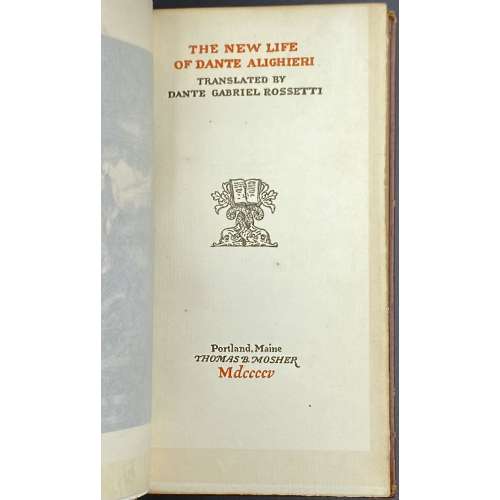 Title: THE NEW LIFE | OF DANTE ALIGHIERI | TRANSLATED BY | DANTE GABRIEL ROSSETTI | {Publisher's device} | Portland, Maine | THOMAS B. MOSHER | Mdccccv Pagination: Ffl [i-viii] ix-xii [xiii] [xiv blank], [1, 2] 3-97 [98] bfl; frontis. w/guard; Note: “This fourth edition on Van Gelder paper consists of 925 copies”. Binding: Hardcover, 18.2 x 10.2 cm, full brown morocco possibly by Sangorski & Sutcliffe, with embossed design elements, raised bands, gilt lettering to spine, TMG, other untrimmed; printed on laid paper with watermark.
Title: THE NEW LIFE | OF DANTE ALIGHIERI | TRANSLATED BY | DANTE GABRIEL ROSSETTI | {Publisher's device} | Portland, Maine | THOMAS B. MOSHER | Mdccccv Pagination: Ffl [i-viii] ix-xii [xiii] [xiv blank], [1, 2] 3-97 [98] bfl; frontis. w/guard; Note: “This fourth edition on Van Gelder paper consists of 925 copies”. Binding: Hardcover, 18.2 x 10.2 cm, full brown morocco possibly by Sangorski & Sutcliffe, with embossed design elements, raised bands, gilt lettering to spine, TMG, other untrimmed; printed on laid paper with watermark. -
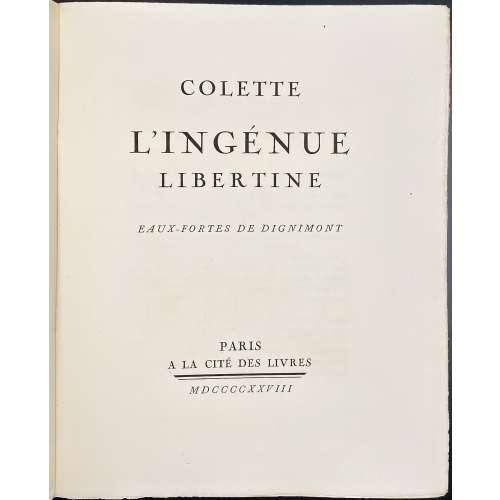 Title-page: COLETTE | L'INGÉNUE | LIBERTINE | EAUX-FORTES DE DIGNIMONT | PARIS | A LA CITÉ DES LIVRES | — | MDCCCCXXVIII || Cover (front wrapper): Similar to t.p. but in red and black: COLETTE | L'INGÉNUE | LIBERTINE | EAUX-FORTES DE DIGNIMONT | PARIS | A LA CITÉ DES LIVRES | — | MDCCCCXXVIII || Description: French flapped wrapper in a red marbled double slipcase with lettered paper label to spine, 29.5 x 23 x 5.5 cm, in-4to, leaves 28 x 22.5 cm. Collation: π4 (π1 in wrapper, π2 blank, π3 h.t. / limitation, π4 t.p. / blank, 1-304, χ2 (χ1 blank, χ2 in wrapper), plus 15 plates extraneous to collation, with tissue-guards, incl. frontispiece. Pagination: [8] [1] 2-237 [238] [6], ils. Plates: 15 etchings in sepia by André Dignimont. Enrichment: Additional full suite of 15 plates in sanguine. Limitation: Edition is limited to 215 copies, 150 of them printed on thick wove paper (Vélin de Hollande), numbered 41 – 190, with one additional suite of plates. This copy is № 168. Printed on October 14, 1928. Contributors: Sidonie-Gabrielle Colette [a.k.a. Colette] (French, 1873 – 1954) André Dignimont (French, 1891 – 1965) – artist. La cité des livres – publishers. R. Coulouma (Argenteuil, director H. Barthélemy) – printer, typography. Atelier de la Roseraie – printer, etchings.
Title-page: COLETTE | L'INGÉNUE | LIBERTINE | EAUX-FORTES DE DIGNIMONT | PARIS | A LA CITÉ DES LIVRES | — | MDCCCCXXVIII || Cover (front wrapper): Similar to t.p. but in red and black: COLETTE | L'INGÉNUE | LIBERTINE | EAUX-FORTES DE DIGNIMONT | PARIS | A LA CITÉ DES LIVRES | — | MDCCCCXXVIII || Description: French flapped wrapper in a red marbled double slipcase with lettered paper label to spine, 29.5 x 23 x 5.5 cm, in-4to, leaves 28 x 22.5 cm. Collation: π4 (π1 in wrapper, π2 blank, π3 h.t. / limitation, π4 t.p. / blank, 1-304, χ2 (χ1 blank, χ2 in wrapper), plus 15 plates extraneous to collation, with tissue-guards, incl. frontispiece. Pagination: [8] [1] 2-237 [238] [6], ils. Plates: 15 etchings in sepia by André Dignimont. Enrichment: Additional full suite of 15 plates in sanguine. Limitation: Edition is limited to 215 copies, 150 of them printed on thick wove paper (Vélin de Hollande), numbered 41 – 190, with one additional suite of plates. This copy is № 168. Printed on October 14, 1928. Contributors: Sidonie-Gabrielle Colette [a.k.a. Colette] (French, 1873 – 1954) André Dignimont (French, 1891 – 1965) – artist. La cité des livres – publishers. R. Coulouma (Argenteuil, director H. Barthélemy) – printer, typography. Atelier de la Roseraie – printer, etchings. -
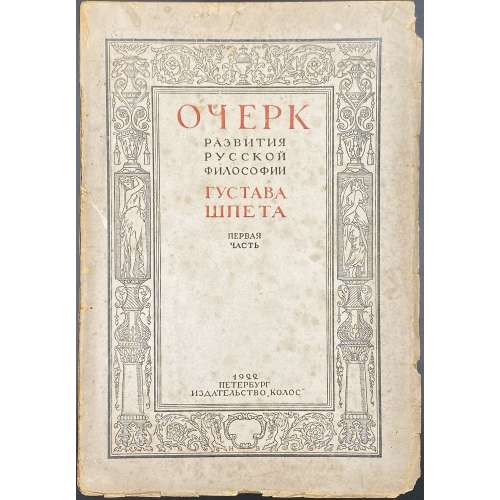 Paperback, 25 x 17 cm, publisher’s wrappers with red and black lettering in a pictorial frame by Vysheslavstev; pp.: [i-vii] viii-xv [xvi blank], [1-5] 6-348 [4]; collated 8vo: π8 1-228, total 184 leaves, 368 pages; gatherings 1-22 uncut. Because the author was banned, lettering on the spine was covered by a glued strip of blank paper; only the year 1922 was left visible. Front wrapper: ОЧЕРК | РАЗВИТИЯ | РУССКОЙ | ФИЛОСОФИИ | ГУСТАВА | ШПЕТА | ПЕРВАЯ | ЧАСТЬ | 1922 | ПЕТЕРБУРГ | ИЗДАТЕЛЬСТВО “КОЛОС” || Title-page: similar lettering in black only with no frame. Design of the front wrapper and the publisher’s device (π1) by Николай Николаевич Вышеславцев [N. Vysheslavstev] (Russian, 1890 – 1952). Title: Sketch on the development of Russian philosophy, Part one. [Part two was never published]. Author: Густав Густавович Шпет [Gustav Shpet] (Russian, 1879 – 1937) – executed by fire squad on 16 November 1937.
Paperback, 25 x 17 cm, publisher’s wrappers with red and black lettering in a pictorial frame by Vysheslavstev; pp.: [i-vii] viii-xv [xvi blank], [1-5] 6-348 [4]; collated 8vo: π8 1-228, total 184 leaves, 368 pages; gatherings 1-22 uncut. Because the author was banned, lettering on the spine was covered by a glued strip of blank paper; only the year 1922 was left visible. Front wrapper: ОЧЕРК | РАЗВИТИЯ | РУССКОЙ | ФИЛОСОФИИ | ГУСТАВА | ШПЕТА | ПЕРВАЯ | ЧАСТЬ | 1922 | ПЕТЕРБУРГ | ИЗДАТЕЛЬСТВО “КОЛОС” || Title-page: similar lettering in black only with no frame. Design of the front wrapper and the publisher’s device (π1) by Николай Николаевич Вышеславцев [N. Vysheslavstev] (Russian, 1890 – 1952). Title: Sketch on the development of Russian philosophy, Part one. [Part two was never published]. Author: Густав Густавович Шпет [Gustav Shpet] (Russian, 1879 – 1937) – executed by fire squad on 16 November 1937. -
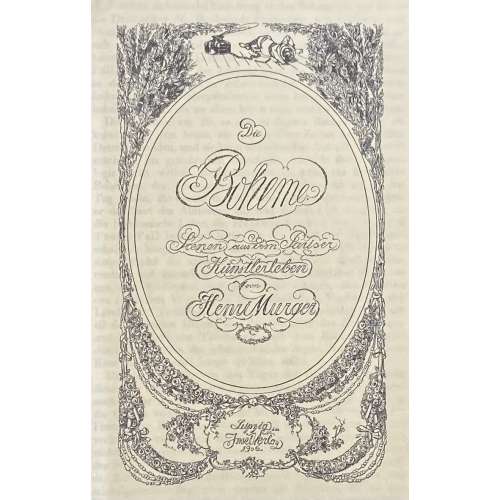 Pictorial title by von Bayros: Die | Bohème. | Scenen aus dem Pariser | Künstlerleben | von | Henri Murger | Leipzig im | InselVerlag | 1906. | F. Bayros || Pagination: [2] – pictorial frontispiece, [2] – pictorial t.p., 1-280 [2] – inhalt, [2] – colophon, [2] – blank, + 4 plates drawn by Franz von Bayros and reproduced as photogravure, with guards. Binding: 23.5 x 15.5 cm, cream parchment, raised bands, gilt-lettered orange morocco label to spine; text printed on laid paper (Linden Paper watermark), untrimmed, illustrations on wove paper as photogravure. Bookplate: “Ex libris Walter Schniewind” engraved by C. L. Becker. Original title: Henry Murger. Scenes De La Vie De Boheme. — Paris: Michel Lévy frères, 1851. Tirage: 50 copies on laid paper, of which this is № 14 (per Sarkowski: 50 numerierte Ex. auf Bütten. Pergament mit Goldschnitt). Author: Murger, Henri [Murger, Louis-Henri, Henry] (French, 1822 – 1861). Translator: Grove, Frederick Philip [Greve, Felix Paul] (German-Canadian, 1879 – 1948). Illustrator: Bayros, Franz von (Austrian, 1866 – 1924). Printer: Drugulin, Wilhelm Eduard (German, 1822 – 1879); Offizin W. Drugulin (Leipzig). Provenance: Schniewind, Walter (German, 1870 – 1927). Catalogue raisonné: Heinz Sarkowski (1999): № 1175 VA, p. 195; Bayros Zeichnungen, pp. 43-46.
Pictorial title by von Bayros: Die | Bohème. | Scenen aus dem Pariser | Künstlerleben | von | Henri Murger | Leipzig im | InselVerlag | 1906. | F. Bayros || Pagination: [2] – pictorial frontispiece, [2] – pictorial t.p., 1-280 [2] – inhalt, [2] – colophon, [2] – blank, + 4 plates drawn by Franz von Bayros and reproduced as photogravure, with guards. Binding: 23.5 x 15.5 cm, cream parchment, raised bands, gilt-lettered orange morocco label to spine; text printed on laid paper (Linden Paper watermark), untrimmed, illustrations on wove paper as photogravure. Bookplate: “Ex libris Walter Schniewind” engraved by C. L. Becker. Original title: Henry Murger. Scenes De La Vie De Boheme. — Paris: Michel Lévy frères, 1851. Tirage: 50 copies on laid paper, of which this is № 14 (per Sarkowski: 50 numerierte Ex. auf Bütten. Pergament mit Goldschnitt). Author: Murger, Henri [Murger, Louis-Henri, Henry] (French, 1822 – 1861). Translator: Grove, Frederick Philip [Greve, Felix Paul] (German-Canadian, 1879 – 1948). Illustrator: Bayros, Franz von (Austrian, 1866 – 1924). Printer: Drugulin, Wilhelm Eduard (German, 1822 – 1879); Offizin W. Drugulin (Leipzig). Provenance: Schniewind, Walter (German, 1870 – 1927). Catalogue raisonné: Heinz Sarkowski (1999): № 1175 VA, p. 195; Bayros Zeichnungen, pp. 43-46. -
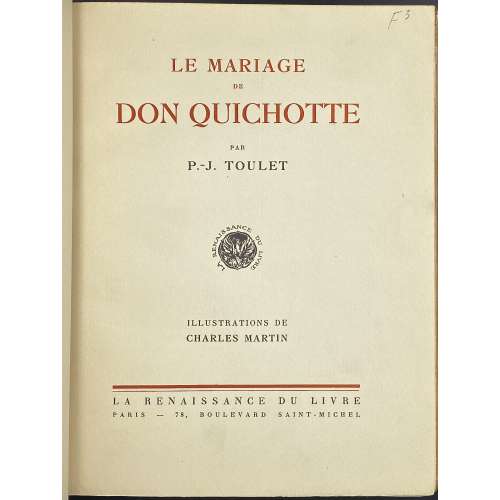 Description: One volume, 25.5 x 19.8 cm, bound in ochre morocco, raised bands, gilt lettering to spine, gilt fillet inside, marbled endpapers, T.E.G., printed on wove paper watermarked “Lafuma”, original wrappers and spine bound in; in a slipcase 26 x 20 cm. Front wrapper and title-page (red and black): LE MARIAGE | DE | DON QUICHOTTE | PAR | P.-J. TOULET | {publisher’s device} | ILLUSTRATIONS DE | (CHARLES) MARTIN | — | LA RENAISSANCE DU LIVRE | PARIS — 78, BOULEVARD SAINT-MICHEL || Collation: two blank leaves, front wrapper, π4 (blank, h.t./limitation, t.p., preface), 1-274, back wrapper, spine, two blank leaves, 112 leaves between the wrappers plus 9 plates extraneous to collation, incl. frontispiece – stencil-coloured photogravures after Charles Martin. Pagination: [8] 1-210 [2] [4], total 224 pages between the wrappers, ils. Limitation: Edition limited to 775 copies, of which 1 copy on Vieux Japon (№ 1), 24 on Japon Imperial (№2-25), and 750 on Vélin Lafuma (№ 26-775). This copy is № 625. Colophon: Printed on November 15, 1922 – text by Coulouma (Argeneuil), director H. Barthélemy, photogravures by Héliogravure de Schutzenberger (Paris), coloured by Charpentier. Contributors: Paul-Jean Toulet (French, 1867 – 1920) – author. Charles Martin (French, 1884 – 1934) – artist. Léon Maurice Schützenberger (French, 1863 – 1950)
Description: One volume, 25.5 x 19.8 cm, bound in ochre morocco, raised bands, gilt lettering to spine, gilt fillet inside, marbled endpapers, T.E.G., printed on wove paper watermarked “Lafuma”, original wrappers and spine bound in; in a slipcase 26 x 20 cm. Front wrapper and title-page (red and black): LE MARIAGE | DE | DON QUICHOTTE | PAR | P.-J. TOULET | {publisher’s device} | ILLUSTRATIONS DE | (CHARLES) MARTIN | — | LA RENAISSANCE DU LIVRE | PARIS — 78, BOULEVARD SAINT-MICHEL || Collation: two blank leaves, front wrapper, π4 (blank, h.t./limitation, t.p., preface), 1-274, back wrapper, spine, two blank leaves, 112 leaves between the wrappers plus 9 plates extraneous to collation, incl. frontispiece – stencil-coloured photogravures after Charles Martin. Pagination: [8] 1-210 [2] [4], total 224 pages between the wrappers, ils. Limitation: Edition limited to 775 copies, of which 1 copy on Vieux Japon (№ 1), 24 on Japon Imperial (№2-25), and 750 on Vélin Lafuma (№ 26-775). This copy is № 625. Colophon: Printed on November 15, 1922 – text by Coulouma (Argeneuil), director H. Barthélemy, photogravures by Héliogravure de Schutzenberger (Paris), coloured by Charpentier. Contributors: Paul-Jean Toulet (French, 1867 – 1920) – author. Charles Martin (French, 1884 – 1934) – artist. Léon Maurice Schützenberger (French, 1863 – 1950) -
 Colour (tone) lithography, image 396 x 508 mm, sheet 532 x 654 mm; before signature, undated; pencil ms inscription: Föhrenhain — E. Pelikan / 200M to the lower-right corner of the sheet. Contributor: Emilie Mediz-Pelikan (Austrian, 1861 – 1908) – artist. Seller's description: Austrian-German painter and graphic artist. Emilie Mediz-Pelikan was born in Vöcklabruck in 1861. She studied at the Vienna Academy and followed her teacher Albert Zimmermann to Salzburg and in 1885 to Munich. In 1891 she married the painter and graphic artist Karl Mediz (1868 - 1945), with whom she lived in Vienna and from 1894 in Dresden. She was in contact with the Dachau Artists' Colony and went on study trips to Paris, Belgium, Hungary and Italy. In the Dachau artists' colony she was friends with Adolf Hölzel and Fritz von Uhde. In 1889 and 1890 she spent time in Paris and in the Belgian artists' colony Knokke. In 1898 she was represented at the first art exhibition of the Vienna Secession, and in 1901 at the International Art Exhibition in Dresden. In 1903 she and her husband had a group exhibition, at the Hagenbund in Vienna. In 1904, she showed graphic works at the Dresden royal court art dealer Richter, and in 1905 and 1906 she exhibited at the Berlin Künstlerhaus. It was not until around 1900 that she achieved her artistic breakthrough with her landscape paintings. Since the estate of the artist, who died prematurely in Dresden in 1908, was lost in the former GDR until the 1980s, it was quite late that the artist was rediscovered and revalued both in Austrian art history and on the art market. In 1986, the first major exhibitions took place at the Upper Austrian State Museum and the University of Applied Arts in Vienna, followed by numerous smaller exhibitions in private galleries in Vienna, Linz and Munich. The artist received recognition during her lifetime from numerous prominent fellow painters as well as from the art critic Ludwig Hevesi. Together with Tina Blau, Herbert Boeckl, Marie Egner, Theodor von Hörmann, Franz Jaschke, Eugen Jettel, Ludwig Heinrich Jungnickel, Rudolf Junk, Gustav Klimt, Oskar Kokoschka, Johann Victor Krämer, Heinrich Kühn, Carl Moll, Rudolf Quittner, Rudolf Ribarz, Emil Jakob Schindler, Max Suppantschitsch, Max Weiler, Olga Wisinger-Florian and Alfred Zoff, she was a protagonist of the reception of Impressionism in Austria. This style went down in Austrian art history under the term "Stimmungsimpressionismus".
Colour (tone) lithography, image 396 x 508 mm, sheet 532 x 654 mm; before signature, undated; pencil ms inscription: Föhrenhain — E. Pelikan / 200M to the lower-right corner of the sheet. Contributor: Emilie Mediz-Pelikan (Austrian, 1861 – 1908) – artist. Seller's description: Austrian-German painter and graphic artist. Emilie Mediz-Pelikan was born in Vöcklabruck in 1861. She studied at the Vienna Academy and followed her teacher Albert Zimmermann to Salzburg and in 1885 to Munich. In 1891 she married the painter and graphic artist Karl Mediz (1868 - 1945), with whom she lived in Vienna and from 1894 in Dresden. She was in contact with the Dachau Artists' Colony and went on study trips to Paris, Belgium, Hungary and Italy. In the Dachau artists' colony she was friends with Adolf Hölzel and Fritz von Uhde. In 1889 and 1890 she spent time in Paris and in the Belgian artists' colony Knokke. In 1898 she was represented at the first art exhibition of the Vienna Secession, and in 1901 at the International Art Exhibition in Dresden. In 1903 she and her husband had a group exhibition, at the Hagenbund in Vienna. In 1904, she showed graphic works at the Dresden royal court art dealer Richter, and in 1905 and 1906 she exhibited at the Berlin Künstlerhaus. It was not until around 1900 that she achieved her artistic breakthrough with her landscape paintings. Since the estate of the artist, who died prematurely in Dresden in 1908, was lost in the former GDR until the 1980s, it was quite late that the artist was rediscovered and revalued both in Austrian art history and on the art market. In 1986, the first major exhibitions took place at the Upper Austrian State Museum and the University of Applied Arts in Vienna, followed by numerous smaller exhibitions in private galleries in Vienna, Linz and Munich. The artist received recognition during her lifetime from numerous prominent fellow painters as well as from the art critic Ludwig Hevesi. Together with Tina Blau, Herbert Boeckl, Marie Egner, Theodor von Hörmann, Franz Jaschke, Eugen Jettel, Ludwig Heinrich Jungnickel, Rudolf Junk, Gustav Klimt, Oskar Kokoschka, Johann Victor Krämer, Heinrich Kühn, Carl Moll, Rudolf Quittner, Rudolf Ribarz, Emil Jakob Schindler, Max Suppantschitsch, Max Weiler, Olga Wisinger-Florian and Alfred Zoff, she was a protagonist of the reception of Impressionism in Austria. This style went down in Austrian art history under the term "Stimmungsimpressionismus". -
![Адарюковъ В.Я. Добавленiя и исправленiя къ подробномусловарю русскихъ гравированныхъ портретовъ Д.А.Ровинскаго, СПб. 1889. — Издание журнала "Старые годы", 1911. — 89 стр. [Владимир Яковлевич Адарюков (1863 -1932). Добавления и исправления к подробному словарю русских гравированных портретов Д.А.Ровинскаго].](https://varshavskycollection.com/wp-content/uploads/2021/02/LIB-1612-a-scaled-500x500.jpg) Title: В. Я. АДАРЮКОВЪ. | ДОБАВЛЕНIЯ И ИСПРАВЛЕНIЯ КЪ ПОДРОБНОМУ СЛОВАРЮ | РУССКИХЪ | ГРАВИРОВАННЫХЪ ПОРТРЕТОВЪ Д. А. РОВИНСКАГО | СПБ. 1889 г. | ИЗДАНИЕ ЖУРНАЛА «СТАРЫЕ ГОДЫ» | 1911. Pagination: [1-4] – incl. orig. wrappers with engraved vignette, 5-89 [90 blank], illustr. Size: 27 x 18.7 cm. Binding: Hardcover; owner's half brown buckram over cloth, original wrappers bound in. Printed on laid paper. Edition: 1st edition, limited: №91 of 150. Inscription to t.p.: Крамарев, 27.5.39. Errata inserts on p. 29 and 77
Title: В. Я. АДАРЮКОВЪ. | ДОБАВЛЕНIЯ И ИСПРАВЛЕНIЯ КЪ ПОДРОБНОМУ СЛОВАРЮ | РУССКИХЪ | ГРАВИРОВАННЫХЪ ПОРТРЕТОВЪ Д. А. РОВИНСКАГО | СПБ. 1889 г. | ИЗДАНИЕ ЖУРНАЛА «СТАРЫЕ ГОДЫ» | 1911. Pagination: [1-4] – incl. orig. wrappers with engraved vignette, 5-89 [90 blank], illustr. Size: 27 x 18.7 cm. Binding: Hardcover; owner's half brown buckram over cloth, original wrappers bound in. Printed on laid paper. Edition: 1st edition, limited: №91 of 150. Inscription to t.p.: Крамарев, 27.5.39. Errata inserts on p. 29 and 77 -
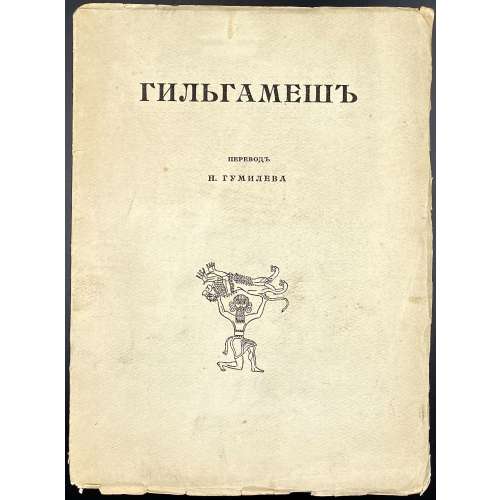 Title page: ГИЛЬГАМЕШЪ | ВАВИЛОНСКIЙ ЭПОСЪ | ПЕРЕВОДЪ | Н. ГУМИЛЕВА | ВВЕДЕНИЕ В. ШИЛЕЙКО | Изданiе З. И. Гржебина | С.-ПЕТЕРБУРГЪ — 1919. Pagination: [1-4] 5-78 [2]; head and tail pieces (William Hayes Ward, The seal cylinders of Western Asia, Washington, 1910). Binding: Publisher’s wrappers, lettering, vignette. Contributors: Гумилёв, Николай Степанович (Russian, 1886 – 1921) – translator from the French. Шилейко, Владимир Казимирович (Russian, 1891 – 1930) – editor.
Title page: ГИЛЬГАМЕШЪ | ВАВИЛОНСКIЙ ЭПОСЪ | ПЕРЕВОДЪ | Н. ГУМИЛЕВА | ВВЕДЕНИЕ В. ШИЛЕЙКО | Изданiе З. И. Гржебина | С.-ПЕТЕРБУРГЪ — 1919. Pagination: [1-4] 5-78 [2]; head and tail pieces (William Hayes Ward, The seal cylinders of Western Asia, Washington, 1910). Binding: Publisher’s wrappers, lettering, vignette. Contributors: Гумилёв, Николай Степанович (Russian, 1886 – 1921) – translator from the French. Шилейко, Владимир Казимирович (Russian, 1891 – 1930) – editor. -
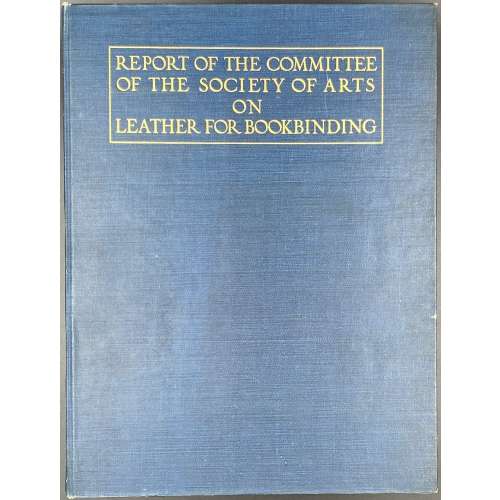 Description: hardcover, 25.2 x 19.2 cm, 8vo, dark blue cloth, gilt lettering in a frame to cover and gilt lettering to spine; captured leather samples pasted to front and back pastedowns, grey endpapers, colour frontispiece, 10 colour plates, multiple in-text b/w illustrations. Collation: a1 blank, a2 h.t./imprint, colour frontis. pasted in, a3 t.p./blank, a4 committee/blank; b2, (no A), B-H8, I5 (10 leaves H1 – I2 with colour plates pasted in, I5 colophon/blank); pagination starts at B2: [1] 2-120 [2]; total a4 b2 B-H8 I5 =67 leaves, 11 colour plates, incl. frontispiece. Title-page: REPORT OF THE COMMITTEE | ON | LEATHER FOR BOOKBINDING. | EDITED FOR | THE SOCIETY OF ARTS | AND | THE WORSHIPFUL COMPANY OF LEATHERSELLERS | BY | THE RT. HON. VISCOUNT COBHAM | CHAIRMAN OF THE COMMITTEE | AND | SIR HENRY TRUEMAN WOOD, M.A. | SECRETARY OF THE SOCIETY | LONDON : | PUBLISHED FOR THE SOCIETY OF ARTS | BY GEORGE BELL & SONS, | YORK HOUSE, PORTUGAL STREET, W.C. | — | 1905 || Contributors: Authors:
Description: hardcover, 25.2 x 19.2 cm, 8vo, dark blue cloth, gilt lettering in a frame to cover and gilt lettering to spine; captured leather samples pasted to front and back pastedowns, grey endpapers, colour frontispiece, 10 colour plates, multiple in-text b/w illustrations. Collation: a1 blank, a2 h.t./imprint, colour frontis. pasted in, a3 t.p./blank, a4 committee/blank; b2, (no A), B-H8, I5 (10 leaves H1 – I2 with colour plates pasted in, I5 colophon/blank); pagination starts at B2: [1] 2-120 [2]; total a4 b2 B-H8 I5 =67 leaves, 11 colour plates, incl. frontispiece. Title-page: REPORT OF THE COMMITTEE | ON | LEATHER FOR BOOKBINDING. | EDITED FOR | THE SOCIETY OF ARTS | AND | THE WORSHIPFUL COMPANY OF LEATHERSELLERS | BY | THE RT. HON. VISCOUNT COBHAM | CHAIRMAN OF THE COMMITTEE | AND | SIR HENRY TRUEMAN WOOD, M.A. | SECRETARY OF THE SOCIETY | LONDON : | PUBLISHED FOR THE SOCIETY OF ARTS | BY GEORGE BELL & SONS, | YORK HOUSE, PORTUGAL STREET, W.C. | — | 1905 || Contributors: Authors:Society of Arts (Great Britain)
Charles George Lyttleton Cobham (British, 1842 – 1922)
Henry Trueman Wood (British, 1879 – 1917), Secretary of the Royal Society of Arts (1879–1917).
George Bell & Sons – publisher. William Clowes and Sons – printer. -
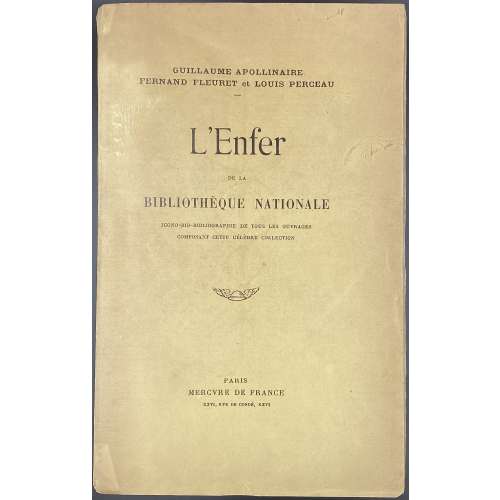 Title: GUILLAUME APOLLINAIRE | FERNAND FLEURET LOUIS PERCEAU | L'Enfer | DE LA | BIBLIOTHÈQUE NATIONALE | ICONO-BIO-BIBLIOGRAPHIE | DESCRIPTIVE, CRITIQUE ET RAISONNÉE, | COMPLÈTE A CE JOUR | DE TOUS LES OUVRAGES COMPOSANT CETTE CÉLÈBRE COLLECTION | AVEC UN INDEX ALPHABÉTIQUE | DES TITRES ET NOMS D'AUTEURS | PARIS | MERCVRE DE FRANCE | XXVI, RVE DE CONDÉ, XXVI | MCMXII || Pagination: ffl, [1-5] 6-415 [416], bfl. Collation: [1]8 2-268. Binding: Original tan wrappers, lettering to covers and spine. Edition: First edition of which this is №952. Ref.: BnF
Title: GUILLAUME APOLLINAIRE | FERNAND FLEURET LOUIS PERCEAU | L'Enfer | DE LA | BIBLIOTHÈQUE NATIONALE | ICONO-BIO-BIBLIOGRAPHIE | DESCRIPTIVE, CRITIQUE ET RAISONNÉE, | COMPLÈTE A CE JOUR | DE TOUS LES OUVRAGES COMPOSANT CETTE CÉLÈBRE COLLECTION | AVEC UN INDEX ALPHABÉTIQUE | DES TITRES ET NOMS D'AUTEURS | PARIS | MERCVRE DE FRANCE | XXVI, RVE DE CONDÉ, XXVI | MCMXII || Pagination: ffl, [1-5] 6-415 [416], bfl. Collation: [1]8 2-268. Binding: Original tan wrappers, lettering to covers and spine. Edition: First edition of which this is №952. Ref.: BnF -
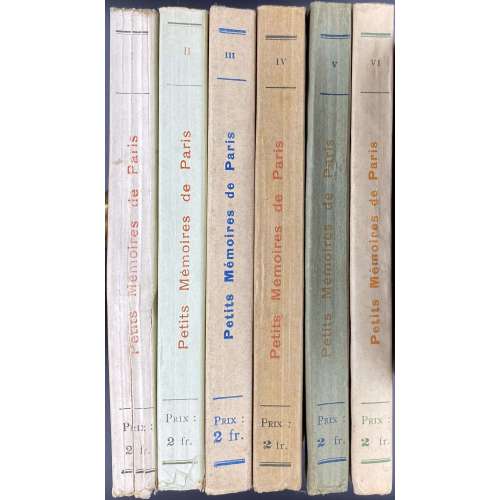 Description: Six softcover volumes, collated in-4to, 14.3 x 10 cm in publisher’s lettered wrappers; printed on laid paper; series "Les petits mémoires de Paris" illustrated with 23 out of 24 etchings by Henri Boutet: (I) Les coulisses de l’amour; (II) Rues et Intérieurs; (III) Le carnet d’un suiveur; (IV) Le petits métiers; (V) Les nuits de Paris; (VI) Toutes les bohêmes. Vol. I: Cream cover, lettered black and red in a black frame: LA MÉSSAGÈRE | LES | PETITS MÉMOIRES | DE | PARIS | CONTENANT | Quatre Eaux-Fortes originales | PAR | Henri BOUTET | I | Les Coulisses de l’Amour | {vignette brown Notre-Dame de Paris} | A PARIS | CHEZ DORBON l’AINÉ, LIBRAIRE | 53 ter, Quai des Grands-Augustins || Title-page: similar, in black, with «MDCCCVIII» in the bottom. Edition not stated. [1-8] ( 7 marked 1) 9-125 [3] contents, colophon; h.t. uncut from 1st blank, three original etchings instead of four (one missing?), incl. frontispiece. Colophon: IMPRIMÉ PAR SOINS | DE LA | SOCIÉTÉ TYPOGRAPHIQUE | DE | CHATEAUDUN || Back wrapper blank. Vol. II: Mint-green cover, lettered black and red in a black frame: LA MÉSSAGÈRE | LES | PETITS MÉMOIRES | DE | PARIS | CONTENANT | Quatre Eaux-Fortes originales | PAR | Henri BOUTET | II | Rues et Intérieurs | {vignette brown Notre-Dame de Paris} | A PARIS | CHEZ DORBON l’AINÉ, LIBRAIRE | 53 ter, Quai des Grands-Augustins || Title-page: similar, in black, with «MDCCCIX» in the bottom. Edition not stated. [1-6] 7-125 [2] contents, colophon (same as in Vol. I); h.t. uncut from 1st blank, four original etchings, incl. frontispiece. Back wrapper blank. Vol. III: Cream cover, lettered blue in a blue frame: LA MÉSSAGÈRE | LES | PETITS MÉMOIRES | DE | PARIS | CONTENANT | Quatre Eaux-Fortes originales | PAR | Henri BOUTET | III | Le Carnet d’un Suiveur | 4e Edition | {vignette smoking gentleman in a top hat} | A PARIS | CHEZ DORBON L’AINÉ, LIBRAIRE | 53 ter, Quai des Grands-Augustins || Title-page: similar, in black, with «MDCCCIX» in the bottom. 4th edition. [1-6] 7-124 [4] contents, colophon (uncut); h.t. uncut from 1st blank, four original etchings, incl. frontispiece. Colophon: Imprimé par soins de | l’Imprimerie de Paris | Têtes de chapitre, lettrines et culs de lampe de | M. Paul Guignebault | Eaux-fortes tirées sous la direction de | M. Henri Boutet || Back wrapper with a frame and a ribbon at center, in blue. Vol. IV: Tan cover, lettered red and black in a black frame: LA MÉSSAGÈRE | LES | PETITS MÉMOIRES | DE | PARIS | CONTENANT | Quatre Eaux-Fortes originales | PAR | Henri BOUTET | IV | Le Petits Métiers | {vignette worker with a ladder} | A PARIS | CHEZ DORBON L’AINÉ, LIBRAIRE | 53 ter, Quai des Grands-Augustins || Title-page: similar, in black, with «MDCCCIX» in the bottom. Edition not stated. [1-6] 7-119 [120 colophon, uncut] [8 advert., uncut]; four original etchings, incl. frontispiece. Colophon: IMPRIMERIE DE PARIS | 22, RUE DES VOLONTAIRES PROLONGÉE | – PARIS - XVe – || Back wrapper with a black frame and a red ribbon at center. Vol. V: Olive-green cover, lettered red and blue in a blue frame: LA MÉSSAGÈRE | LES | PETITS MÉMOIRES | DE | PARIS | CONTENANT | Quatre Eaux-Fortes originales | PAR | Henri BOUTET | V | Les nuits de Paris | Deuxième Édition | {vignette woman on a street} | A PARIS | CHEZ DORBON L’AINÉ, LIBRAIRE | 53 ter, Quai des Grands-Augustins || Title-page: similar, in black, with «MDCDIX» in the bottom. 2nd edition. [1-8] 9-118 [2 colophon, uncut] [8 advert., uncut]; four original etchings, incl. frontispiece. Colophon: IMPRIMERIE DE PARIS | 22, RUE DES VOLONTAIRES PROLONGÉE | – PARIS - XVe – || Back wrapper with a blue frame and a red ribbon at center. Vol. VI: Cream cover, lettered red and blue in a blue frame: LA MÉSSAGÈRE | LES | PETITS MÉMOIRES | DE | PARIS | CONTENANT | Quatre Eaux-Fortes originales | PAR | Henri BOUTET | VI | Toutes les bohêmes | Cinquième Édition | {vignette windmill} | A PARIS | CHEZ DORBON L’AINÉ, LIBRAIRE | 53 ter, Quai des Grands-Augustins || Title-page: similar, in black, with «MDCDIX» in the bottom and “Deuxième Édition”. 5th or 2nd edition. [1-7] 8-120 [2 colophon] [4 advert.] [2 blank]; four original etchings, incl. frontispiece. Colophon: IMPRIMERIE DE PARIS | 22, RUE DES VOLONTAIRES PROLONGÉE | – PARIS - XVe – || Back wrapper with a blue frame and a red ribbon at center. Contributors: Henri Boutet [La Mésangère] (French, 1851 – 1919) – author, artist, etcher. François Louis Dorbon [Dorbon Aîné] (French, 1878 – 1956) – publisher.
Description: Six softcover volumes, collated in-4to, 14.3 x 10 cm in publisher’s lettered wrappers; printed on laid paper; series "Les petits mémoires de Paris" illustrated with 23 out of 24 etchings by Henri Boutet: (I) Les coulisses de l’amour; (II) Rues et Intérieurs; (III) Le carnet d’un suiveur; (IV) Le petits métiers; (V) Les nuits de Paris; (VI) Toutes les bohêmes. Vol. I: Cream cover, lettered black and red in a black frame: LA MÉSSAGÈRE | LES | PETITS MÉMOIRES | DE | PARIS | CONTENANT | Quatre Eaux-Fortes originales | PAR | Henri BOUTET | I | Les Coulisses de l’Amour | {vignette brown Notre-Dame de Paris} | A PARIS | CHEZ DORBON l’AINÉ, LIBRAIRE | 53 ter, Quai des Grands-Augustins || Title-page: similar, in black, with «MDCCCVIII» in the bottom. Edition not stated. [1-8] ( 7 marked 1) 9-125 [3] contents, colophon; h.t. uncut from 1st blank, three original etchings instead of four (one missing?), incl. frontispiece. Colophon: IMPRIMÉ PAR SOINS | DE LA | SOCIÉTÉ TYPOGRAPHIQUE | DE | CHATEAUDUN || Back wrapper blank. Vol. II: Mint-green cover, lettered black and red in a black frame: LA MÉSSAGÈRE | LES | PETITS MÉMOIRES | DE | PARIS | CONTENANT | Quatre Eaux-Fortes originales | PAR | Henri BOUTET | II | Rues et Intérieurs | {vignette brown Notre-Dame de Paris} | A PARIS | CHEZ DORBON l’AINÉ, LIBRAIRE | 53 ter, Quai des Grands-Augustins || Title-page: similar, in black, with «MDCCCIX» in the bottom. Edition not stated. [1-6] 7-125 [2] contents, colophon (same as in Vol. I); h.t. uncut from 1st blank, four original etchings, incl. frontispiece. Back wrapper blank. Vol. III: Cream cover, lettered blue in a blue frame: LA MÉSSAGÈRE | LES | PETITS MÉMOIRES | DE | PARIS | CONTENANT | Quatre Eaux-Fortes originales | PAR | Henri BOUTET | III | Le Carnet d’un Suiveur | 4e Edition | {vignette smoking gentleman in a top hat} | A PARIS | CHEZ DORBON L’AINÉ, LIBRAIRE | 53 ter, Quai des Grands-Augustins || Title-page: similar, in black, with «MDCCCIX» in the bottom. 4th edition. [1-6] 7-124 [4] contents, colophon (uncut); h.t. uncut from 1st blank, four original etchings, incl. frontispiece. Colophon: Imprimé par soins de | l’Imprimerie de Paris | Têtes de chapitre, lettrines et culs de lampe de | M. Paul Guignebault | Eaux-fortes tirées sous la direction de | M. Henri Boutet || Back wrapper with a frame and a ribbon at center, in blue. Vol. IV: Tan cover, lettered red and black in a black frame: LA MÉSSAGÈRE | LES | PETITS MÉMOIRES | DE | PARIS | CONTENANT | Quatre Eaux-Fortes originales | PAR | Henri BOUTET | IV | Le Petits Métiers | {vignette worker with a ladder} | A PARIS | CHEZ DORBON L’AINÉ, LIBRAIRE | 53 ter, Quai des Grands-Augustins || Title-page: similar, in black, with «MDCCCIX» in the bottom. Edition not stated. [1-6] 7-119 [120 colophon, uncut] [8 advert., uncut]; four original etchings, incl. frontispiece. Colophon: IMPRIMERIE DE PARIS | 22, RUE DES VOLONTAIRES PROLONGÉE | – PARIS - XVe – || Back wrapper with a black frame and a red ribbon at center. Vol. V: Olive-green cover, lettered red and blue in a blue frame: LA MÉSSAGÈRE | LES | PETITS MÉMOIRES | DE | PARIS | CONTENANT | Quatre Eaux-Fortes originales | PAR | Henri BOUTET | V | Les nuits de Paris | Deuxième Édition | {vignette woman on a street} | A PARIS | CHEZ DORBON L’AINÉ, LIBRAIRE | 53 ter, Quai des Grands-Augustins || Title-page: similar, in black, with «MDCDIX» in the bottom. 2nd edition. [1-8] 9-118 [2 colophon, uncut] [8 advert., uncut]; four original etchings, incl. frontispiece. Colophon: IMPRIMERIE DE PARIS | 22, RUE DES VOLONTAIRES PROLONGÉE | – PARIS - XVe – || Back wrapper with a blue frame and a red ribbon at center. Vol. VI: Cream cover, lettered red and blue in a blue frame: LA MÉSSAGÈRE | LES | PETITS MÉMOIRES | DE | PARIS | CONTENANT | Quatre Eaux-Fortes originales | PAR | Henri BOUTET | VI | Toutes les bohêmes | Cinquième Édition | {vignette windmill} | A PARIS | CHEZ DORBON L’AINÉ, LIBRAIRE | 53 ter, Quai des Grands-Augustins || Title-page: similar, in black, with «MDCDIX» in the bottom and “Deuxième Édition”. 5th or 2nd edition. [1-7] 8-120 [2 colophon] [4 advert.] [2 blank]; four original etchings, incl. frontispiece. Colophon: IMPRIMERIE DE PARIS | 22, RUE DES VOLONTAIRES PROLONGÉE | – PARIS - XVe – || Back wrapper with a blue frame and a red ribbon at center. Contributors: Henri Boutet [La Mésangère] (French, 1851 – 1919) – author, artist, etcher. François Louis Dorbon [Dorbon Aîné] (French, 1878 – 1956) – publisher. -
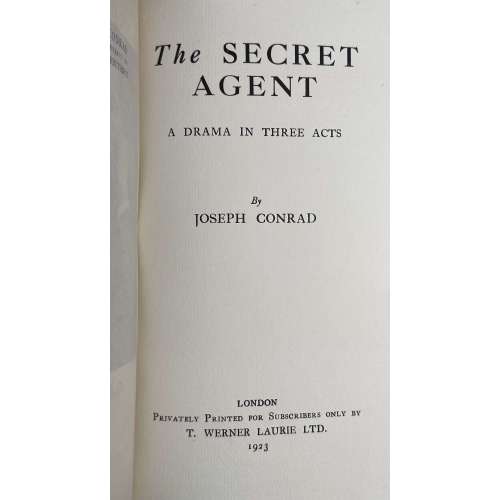 Hardcover volume, 24 x 15 cm, bound in quarter parchment over pale blue cloth, paper label to spine, pale blue dust jacket with a paper label, another label bound in at the end, printed on thick laid paper, untrimmed, uncut, pp. [4] blank, [2] blank/advert., [2] h.t./blank, t.p./imprint (riverside press Ltd.), [2] limitation/blank, [2] persons/blank, [1] 2-185 [3], photogravure portrait frontispiece by Emery Walker with captioned tissue guard. Title-page: The SECRET AGENT | A DRAMA IN THREE ACTS | by | JOSEPH CONRAD | LONDON | Privately Printed for Subscribers ONLY BY | T. WERNER LAURIE LTD. | 1923 || Edition: Limited edition of 1,000 copies sighed by the author; this is copy № 12. Catalogue Raisonné: Keating № 79 / p. 169. Seller’s Description: one of 1000 copies signed by the author, photogravure portrait frontispiece by Emery Walker, endpapers lightly browned, original parchment-backed boards, dust-jacket, spine lightly browned with 2 small staining spots, ends a little creased, uncut and unopened, overall an excellent copy, 8vo, 1923. Contributors: Joseph Conrad (Polish-British, 1857 – 1924) – author. Thomas Werner Laurie (British, 1866 – 1944) – publisher. Emery Walker (British, 1851 – 1933) – artist. The Riverside Press Limited (Edinburgh) – printer. First edition: [LIB-2762.2021] Joseph Conrad. The secret agent: a simple tale. — London: Methuen & Co., [1907]
Hardcover volume, 24 x 15 cm, bound in quarter parchment over pale blue cloth, paper label to spine, pale blue dust jacket with a paper label, another label bound in at the end, printed on thick laid paper, untrimmed, uncut, pp. [4] blank, [2] blank/advert., [2] h.t./blank, t.p./imprint (riverside press Ltd.), [2] limitation/blank, [2] persons/blank, [1] 2-185 [3], photogravure portrait frontispiece by Emery Walker with captioned tissue guard. Title-page: The SECRET AGENT | A DRAMA IN THREE ACTS | by | JOSEPH CONRAD | LONDON | Privately Printed for Subscribers ONLY BY | T. WERNER LAURIE LTD. | 1923 || Edition: Limited edition of 1,000 copies sighed by the author; this is copy № 12. Catalogue Raisonné: Keating № 79 / p. 169. Seller’s Description: one of 1000 copies signed by the author, photogravure portrait frontispiece by Emery Walker, endpapers lightly browned, original parchment-backed boards, dust-jacket, spine lightly browned with 2 small staining spots, ends a little creased, uncut and unopened, overall an excellent copy, 8vo, 1923. Contributors: Joseph Conrad (Polish-British, 1857 – 1924) – author. Thomas Werner Laurie (British, 1866 – 1944) – publisher. Emery Walker (British, 1851 – 1933) – artist. The Riverside Press Limited (Edinburgh) – printer. First edition: [LIB-2762.2021] Joseph Conrad. The secret agent: a simple tale. — London: Methuen & Co., [1907] -
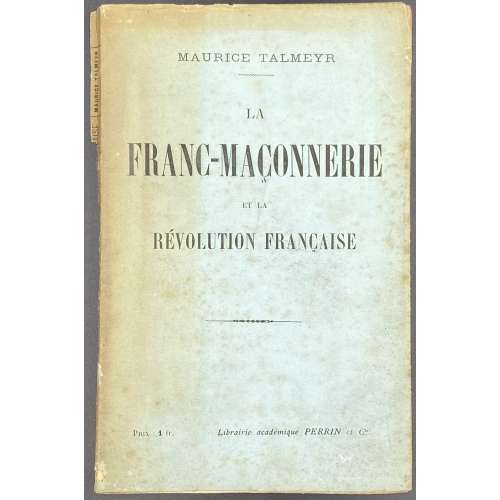 Cover: MAURICE TALMEYR | LA | FRANC-MAÇONNERIE | ET LA | RÉVOLUTION FRANÇAISE | — | Prix : 1 fr. […] Librairie académique PERRIN et Cie. Title page: MAURICE TALMEYR | LA | FRANC-MAÇONNERIE | ET LA | RÉVOLUTION FRANÇAISE | — | PARIS | LIBRAIRIE ACADÉMIQUE DIDIER | PERRIN ET Cie, LIBRAIRES–ÉDITEURS | 35, QUAI DES GRANDS-AUGUSTINS, 35 | 1904 | Tous droits réservés || Autograph: Inscription to h.t. to Charles Foley from the author. Bibiographical description: Blue lettered publisher’s wrappers, 19 x 12 cm, pagination: [8] [1] 2-94 [2], collation: 8vo, π4 1-68. The Russian translation Н. Л. Фран-масонство и государственная измена. — СПб.: Издание В. П., 1906 is here: LIB-0940.2016. Contributors: Maurice Talmeyr [Marie-Justin-Maurice Coste] (French, 1850 – 1931) Pierre-Paul Didier (French, 1800 – 1865) Émile Perrin (French, 1828 – 1884)
Cover: MAURICE TALMEYR | LA | FRANC-MAÇONNERIE | ET LA | RÉVOLUTION FRANÇAISE | — | Prix : 1 fr. […] Librairie académique PERRIN et Cie. Title page: MAURICE TALMEYR | LA | FRANC-MAÇONNERIE | ET LA | RÉVOLUTION FRANÇAISE | — | PARIS | LIBRAIRIE ACADÉMIQUE DIDIER | PERRIN ET Cie, LIBRAIRES–ÉDITEURS | 35, QUAI DES GRANDS-AUGUSTINS, 35 | 1904 | Tous droits réservés || Autograph: Inscription to h.t. to Charles Foley from the author. Bibiographical description: Blue lettered publisher’s wrappers, 19 x 12 cm, pagination: [8] [1] 2-94 [2], collation: 8vo, π4 1-68. The Russian translation Н. Л. Фран-масонство и государственная измена. — СПб.: Издание В. П., 1906 is here: LIB-0940.2016. Contributors: Maurice Talmeyr [Marie-Justin-Maurice Coste] (French, 1850 – 1931) Pierre-Paul Didier (French, 1800 – 1865) Émile Perrin (French, 1828 – 1884) -
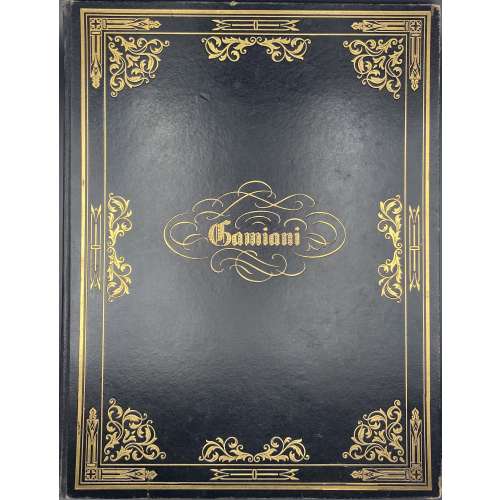 A German translation of de Musset’s “Gamiani ou deux nuits d’excès” illustrated with a reprint title-page and 11 (instead of 16) hand-coloured photogravures after original lithographs by Devéria and Henri Grévedon or Octave Tassaert for 1833 edition, though from the re-drawn stones. Large volume, 40.5 x 31 cm, collated 4to, in black calf with lettering and elaborate gilt border to front and blind border to back, outer and bottom margins uncut, marbled endpapers, text and plates printed on wove paper. The reprint t.p. is different from the original one; in the 1833 edition, the line deux nuits d’excès is waving while here it is straight. Letterpress title-page: ALFRED DE MUSSET | GAMIANI | ODER | ZWEI NÄCHTE DER AUSSCHWEIFUNG || Reprint title-page: Gamiani | OU | DEUX NUITS D’EXCÈS. | {vignette} | Bruxelles | 1833 || Collation: π2 1-74 82, total 32 leaves plus reprint t.p. and 11 plates. Pagination: [4] [1] 2-59 [60], total 64 pages, ils. Limitation: Edition limited to 300 numbered copies, of which this is copy № 32. Contributors: Alfred de Musset (French, 1810 – 1857) – author. Karl Spieler (German, 19th/20th century) – author of the foreword and translator. Achille Devéria (French, 1800 – 1857) – artist (attributed). Pierre Louis Henri Grévedon (French, 1776 – 1860) – artist (attributed). Octave Tassaert (French, 1800 – 1874) – artist (attributed). Catalogue raisonné: Dutel (1650-1880) № A-460, p. 149; Eros invaincu № 68, p. 171-3.
A German translation of de Musset’s “Gamiani ou deux nuits d’excès” illustrated with a reprint title-page and 11 (instead of 16) hand-coloured photogravures after original lithographs by Devéria and Henri Grévedon or Octave Tassaert for 1833 edition, though from the re-drawn stones. Large volume, 40.5 x 31 cm, collated 4to, in black calf with lettering and elaborate gilt border to front and blind border to back, outer and bottom margins uncut, marbled endpapers, text and plates printed on wove paper. The reprint t.p. is different from the original one; in the 1833 edition, the line deux nuits d’excès is waving while here it is straight. Letterpress title-page: ALFRED DE MUSSET | GAMIANI | ODER | ZWEI NÄCHTE DER AUSSCHWEIFUNG || Reprint title-page: Gamiani | OU | DEUX NUITS D’EXCÈS. | {vignette} | Bruxelles | 1833 || Collation: π2 1-74 82, total 32 leaves plus reprint t.p. and 11 plates. Pagination: [4] [1] 2-59 [60], total 64 pages, ils. Limitation: Edition limited to 300 numbered copies, of which this is copy № 32. Contributors: Alfred de Musset (French, 1810 – 1857) – author. Karl Spieler (German, 19th/20th century) – author of the foreword and translator. Achille Devéria (French, 1800 – 1857) – artist (attributed). Pierre Louis Henri Grévedon (French, 1776 – 1860) – artist (attributed). Octave Tassaert (French, 1800 – 1874) – artist (attributed). Catalogue raisonné: Dutel (1650-1880) № A-460, p. 149; Eros invaincu № 68, p. 171-3. -
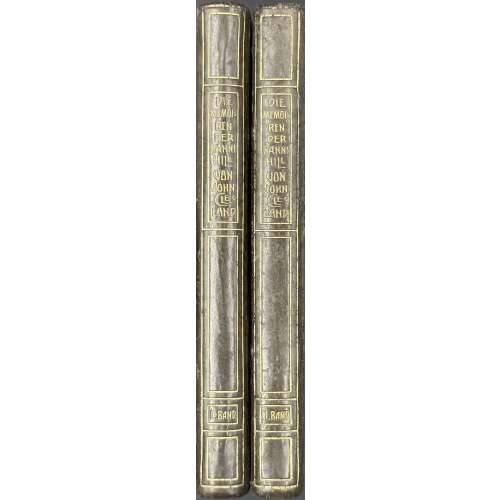 Two hardcover volumes, 17 x 11.5 cm, collated in-8vo, uniformly bound in dark grey mottled calf bordered with gilt fillet, flat spine with gilt lettering in compartments outlined in gilt; top edge gilt, text and plates printed on dense wove paper (Japanpapier). Privately printed by Gustav Röttig & Sohn (Ödenburg) in 800 copies, of which this is copy № 16, signed by von Bayros in 1st vol. Each volume is illustrated with four heliogravures (title-page and three plates) after drawings by Franz von Bayros. According to the seller, this is one of only 35 copies of the deluxe edition on Japanpapier, a fact which was mentioned by the bibliographers but not in the imprint. Bookplate to front pastedown in each volume, lettering to bottom “Ex libris Dr. phil. Rudolf Ludwig”, 120 x 100 mm, heliogravure after von Bayros. Pp.: vol. 1 [4] 1-198 plus engraved t.p. and 3 plates. Vol. 2: 1-204 [2] plus engraved t.p. and 3 plates. Title-page: DIE MEMOIREN | DER | FANNY HILL | VON | JOHN CLELAND | ESTER (ZWEITER) BAND | PAPHOS IM JAHR DER | CYTHERE | MDCCCCVI || Author of the text: John Cleland (British, c. 1709 – 1789). Translator: Franz Blei [Dr. Erich Feldhammer] (Austrian, 1871 – 1942). Illustrator: Franz von Bayros (Austrian, 1866 – 1924). Provenance: Dr. Phil. Rudolf Ludwig. Catalogue raisonné: The amorous drawings of the Marquis von Bayros. — New York: Cythera Press, 1968. The Beautiful Maiden of Pao, pp. 31-38. Seller's Description: Erster [und] Zweiter Band. Paphos [Wien, C. W. Stern], im Jahr der Cythere 1906. Mit sechs Tafeln und zwei illustrierten Titeln nach Franz von Bayros, alle zweifarbig. Grau marmorierte Originalkalblederbände mit Rücken-, Deckelkanten- und Kopfschnittvergoldung. Privatdruck. – Eins von 35 Exemplaren der Luxusausgabe auf Japanpapier, im Druckvermerk von Band I von Bayros signiert. – Die Übersetzung stammt von Franz Blei, der hier unter dem Pseudonym Dr. Erich Feldhammer genannt wird. Als Textvorlage diente die Ausgabe London 1749. – Gedruckt wurde bei Gustav Röttig & Sohn in Ödenburg. – Sehr seltene Vorzugsausgabe, die zwar bei den Bibliographen, nicht aber im Druckvermerk genannt wurde. – Fast tadellos. – »Dieses Werk ist eines der berühmtesten in der erotischen Literatur« (Stern-Szana). Nach Hinweis bei Brettschneider wurde die Auflage beschlagnahmt. – Exlibris Dr. phil. Rudolf Ludwig, Wien (Heliogravüre nach Zeichnung von Franz von Bayros, Brettschneider 156) in beiden Bänden. 17 : 11,5 cm. [4], 198, [2], [4], 204, [2] Seiten. Zusammen 8 Tafeln. Brettschneider 38. – Hayn/Gotendorf I, 618. – Stern-Szana 243 und ausführlich S. 222ff
Two hardcover volumes, 17 x 11.5 cm, collated in-8vo, uniformly bound in dark grey mottled calf bordered with gilt fillet, flat spine with gilt lettering in compartments outlined in gilt; top edge gilt, text and plates printed on dense wove paper (Japanpapier). Privately printed by Gustav Röttig & Sohn (Ödenburg) in 800 copies, of which this is copy № 16, signed by von Bayros in 1st vol. Each volume is illustrated with four heliogravures (title-page and three plates) after drawings by Franz von Bayros. According to the seller, this is one of only 35 copies of the deluxe edition on Japanpapier, a fact which was mentioned by the bibliographers but not in the imprint. Bookplate to front pastedown in each volume, lettering to bottom “Ex libris Dr. phil. Rudolf Ludwig”, 120 x 100 mm, heliogravure after von Bayros. Pp.: vol. 1 [4] 1-198 plus engraved t.p. and 3 plates. Vol. 2: 1-204 [2] plus engraved t.p. and 3 plates. Title-page: DIE MEMOIREN | DER | FANNY HILL | VON | JOHN CLELAND | ESTER (ZWEITER) BAND | PAPHOS IM JAHR DER | CYTHERE | MDCCCCVI || Author of the text: John Cleland (British, c. 1709 – 1789). Translator: Franz Blei [Dr. Erich Feldhammer] (Austrian, 1871 – 1942). Illustrator: Franz von Bayros (Austrian, 1866 – 1924). Provenance: Dr. Phil. Rudolf Ludwig. Catalogue raisonné: The amorous drawings of the Marquis von Bayros. — New York: Cythera Press, 1968. The Beautiful Maiden of Pao, pp. 31-38. Seller's Description: Erster [und] Zweiter Band. Paphos [Wien, C. W. Stern], im Jahr der Cythere 1906. Mit sechs Tafeln und zwei illustrierten Titeln nach Franz von Bayros, alle zweifarbig. Grau marmorierte Originalkalblederbände mit Rücken-, Deckelkanten- und Kopfschnittvergoldung. Privatdruck. – Eins von 35 Exemplaren der Luxusausgabe auf Japanpapier, im Druckvermerk von Band I von Bayros signiert. – Die Übersetzung stammt von Franz Blei, der hier unter dem Pseudonym Dr. Erich Feldhammer genannt wird. Als Textvorlage diente die Ausgabe London 1749. – Gedruckt wurde bei Gustav Röttig & Sohn in Ödenburg. – Sehr seltene Vorzugsausgabe, die zwar bei den Bibliographen, nicht aber im Druckvermerk genannt wurde. – Fast tadellos. – »Dieses Werk ist eines der berühmtesten in der erotischen Literatur« (Stern-Szana). Nach Hinweis bei Brettschneider wurde die Auflage beschlagnahmt. – Exlibris Dr. phil. Rudolf Ludwig, Wien (Heliogravüre nach Zeichnung von Franz von Bayros, Brettschneider 156) in beiden Bänden. 17 : 11,5 cm. [4], 198, [2], [4], 204, [2] Seiten. Zusammen 8 Tafeln. Brettschneider 38. – Hayn/Gotendorf I, 618. – Stern-Szana 243 und ausführlich S. 222ff -
![George Cruikshank : A Catalogue Raisonné Of The Work Executed During The Years 1806-1877; With Collations, Notes, Approximate Values, Facsimiles, And Illustrationsby Albert M. Cohn, author of a bibliographical catalogue of the printed works illustrated by George Cruikshank, etc. London : Office of "The Bookman's Jounral", 1924. [Cohn, Albert M.]](https://varshavskycollection.com/wp-content/uploads/2021/02/LIB-1650-c-scaled-500x500.jpg) GEORGE CRUIKSHANK | A CATALOGUE RAISONNÉ | OF THE WORK EXECUTED | DURING THE YEARS 1806-1877 | WITH COLLATIONS, NOTES, APPROXIMATE VALUES, | FACSIMILES, AND ILLUSTRATIONS | BY | ALBERT M. COHN | Author of A Bibliographical Catalogue of the Printed | Works Illustrated By George Cruikshank, etc. | LONDON |FROM THE OFFICE OF "THE BOOKMAN'S JOURNAL" | 7 HENRIETTA STREET, STRAND, W.C.2 | 1924. Pagination: ffl, [i, ii] – h.t. / Limited edition (122 of 500), [2] – blank / frontis. lith. portrait of G. Cruikshank w/guard, [iii, iv] – t.p. / printed in G.B., [v, vi] – dedicat. / blank, vii-xvi; [1, 2] – f.t. / blank, 3-375, [376] – Imprint., bfl; 31 leaves of plates, some mounted. Binding: size 30 x 24 x 5.5 cm, hardcover, bevelled boards, original brown cloth with gilded lettering to spine. Top edge gilt, other untrimmed; printed on laid paper. To front pastedown: "Ex libris – Fred Robison Heryer" (round, 55 mm, resembles a coin, printed on heavy gold-coloured foil with embossed lettering and an image of a seated man lettered ALEXANDROY in Greek. To back pastedown: Seller's sticker "From the book of J.W.Robinson Co., Seventh & Grand, Los Angeles." J. W. Robinson Co. – a chain of department stores, established by Joseph Winchester Robinson (American, 1846 – 1891). Some Fred Robison Heryer (American, 1907 – 1992) died in Kansas.
GEORGE CRUIKSHANK | A CATALOGUE RAISONNÉ | OF THE WORK EXECUTED | DURING THE YEARS 1806-1877 | WITH COLLATIONS, NOTES, APPROXIMATE VALUES, | FACSIMILES, AND ILLUSTRATIONS | BY | ALBERT M. COHN | Author of A Bibliographical Catalogue of the Printed | Works Illustrated By George Cruikshank, etc. | LONDON |FROM THE OFFICE OF "THE BOOKMAN'S JOURNAL" | 7 HENRIETTA STREET, STRAND, W.C.2 | 1924. Pagination: ffl, [i, ii] – h.t. / Limited edition (122 of 500), [2] – blank / frontis. lith. portrait of G. Cruikshank w/guard, [iii, iv] – t.p. / printed in G.B., [v, vi] – dedicat. / blank, vii-xvi; [1, 2] – f.t. / blank, 3-375, [376] – Imprint., bfl; 31 leaves of plates, some mounted. Binding: size 30 x 24 x 5.5 cm, hardcover, bevelled boards, original brown cloth with gilded lettering to spine. Top edge gilt, other untrimmed; printed on laid paper. To front pastedown: "Ex libris – Fred Robison Heryer" (round, 55 mm, resembles a coin, printed on heavy gold-coloured foil with embossed lettering and an image of a seated man lettered ALEXANDROY in Greek. To back pastedown: Seller's sticker "From the book of J.W.Robinson Co., Seventh & Grand, Los Angeles." J. W. Robinson Co. – a chain of department stores, established by Joseph Winchester Robinson (American, 1846 – 1891). Some Fred Robison Heryer (American, 1907 – 1992) died in Kansas. -
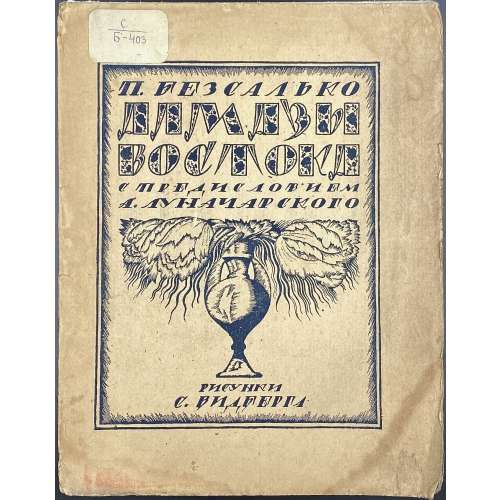 Publisher’s pictorial wrappers, to front wrapper in frame “П. БЕЗСАЛЬКО | АЛМАЗЫ | ВОСТОКА | С ПРЕДИСЛОВИЕМ | А. ЛУНАЧАРСКОГО | {vignette vase with flowers} | РИСУНКИ | С. ВИТБЕРГА || Ex-library book with stamps and stickers. Title page: П. БЕЗСАЛЬКО | АЛМАЗЫ | ВОСТОКА | {publisher’s device «КНИГОИЗДАТЕЛЬСТВО ПЕТРОГРАДСКОГО СОВДЕПА / КНИГА НАРОДУ» | Издание Петроградского Совета | Рабочих и Красн. Депутатов | 1919 || Pagination: [1-4] 5-85 [3], total 88 pages, 12 full-page black and white plates. Collation: 8vo; [1]-58 64, total 44 leaves, plates within collation. Contributors: Безсалько, Павел Карпович (Russian, 1887 – 1920) – author. Луначарский, Анатолий Васильевич (Russian, 1875 – 1933) – author if the foreword. Vidbergs, Sigismunds (Latvian-American, 1890 – 1970) – artist. Бельгова, Полина Борисовна (written "ПОЛИНА БОРИСОВНА ЬЕЛЬГОВА") – dedicatee, unidentified.
Publisher’s pictorial wrappers, to front wrapper in frame “П. БЕЗСАЛЬКО | АЛМАЗЫ | ВОСТОКА | С ПРЕДИСЛОВИЕМ | А. ЛУНАЧАРСКОГО | {vignette vase with flowers} | РИСУНКИ | С. ВИТБЕРГА || Ex-library book with stamps and stickers. Title page: П. БЕЗСАЛЬКО | АЛМАЗЫ | ВОСТОКА | {publisher’s device «КНИГОИЗДАТЕЛЬСТВО ПЕТРОГРАДСКОГО СОВДЕПА / КНИГА НАРОДУ» | Издание Петроградского Совета | Рабочих и Красн. Депутатов | 1919 || Pagination: [1-4] 5-85 [3], total 88 pages, 12 full-page black and white plates. Collation: 8vo; [1]-58 64, total 44 leaves, plates within collation. Contributors: Безсалько, Павел Карпович (Russian, 1887 – 1920) – author. Луначарский, Анатолий Васильевич (Russian, 1875 – 1933) – author if the foreword. Vidbergs, Sigismunds (Latvian-American, 1890 – 1970) – artist. Бельгова, Полина Борисовна (written "ПОЛИНА БОРИСОВНА ЬЕЛЬГОВА") – dedicatee, unidentified. -
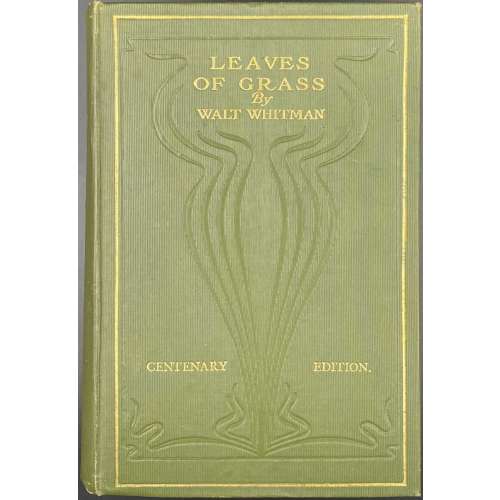 Hardcover, 21.5 x 15 cm, green buckram with gilt border and gilt lettering to front board and spine, blind decorated in art nouveau style, T.E.G. Pagination: [26] 1-294, [4] 1-323 [324], [4] 1-255 [256] [4]; total 912 pages and photo portrait frontispiece. Title-page: THREE VOLUMES IN ONE | LEAVES OF GRASS| WALT WHITMAN | ISSUED UNDER THE | EDITORIAL SUPERVISION OF HIS | LITERARY EXECUTORS, RICHARD MAURICE | BUCKE, THOMAS B. HARNED, AND | HORACE L. TRAUBEL | {device} | D. APPLETON AND COMPANY | New York […] London || For the Russian translation, see LIB-3103.2022 Уолт Уитмен. Листья травы / Пер. с англ. Вступ. статьи К. Чуковского и М. Медельсона. — М.: Государственное издательство художественной литературы, 1955. Contributors: Walter [Walt] Whitman (American, 1819 – 1892) Richard Maurice Bucke (Canadian, 1837 – 1902) Thomas Biggs Harned (American, 1851 – 1921) Horace Logo Traubel (American, 1858 – 1919)
Hardcover, 21.5 x 15 cm, green buckram with gilt border and gilt lettering to front board and spine, blind decorated in art nouveau style, T.E.G. Pagination: [26] 1-294, [4] 1-323 [324], [4] 1-255 [256] [4]; total 912 pages and photo portrait frontispiece. Title-page: THREE VOLUMES IN ONE | LEAVES OF GRASS| WALT WHITMAN | ISSUED UNDER THE | EDITORIAL SUPERVISION OF HIS | LITERARY EXECUTORS, RICHARD MAURICE | BUCKE, THOMAS B. HARNED, AND | HORACE L. TRAUBEL | {device} | D. APPLETON AND COMPANY | New York […] London || For the Russian translation, see LIB-3103.2022 Уолт Уитмен. Листья травы / Пер. с англ. Вступ. статьи К. Чуковского и М. Медельсона. — М.: Государственное издательство художественной литературы, 1955. Contributors: Walter [Walt] Whitman (American, 1819 – 1892) Richard Maurice Bucke (Canadian, 1837 – 1902) Thomas Biggs Harned (American, 1851 – 1921) Horace Logo Traubel (American, 1858 – 1919) -
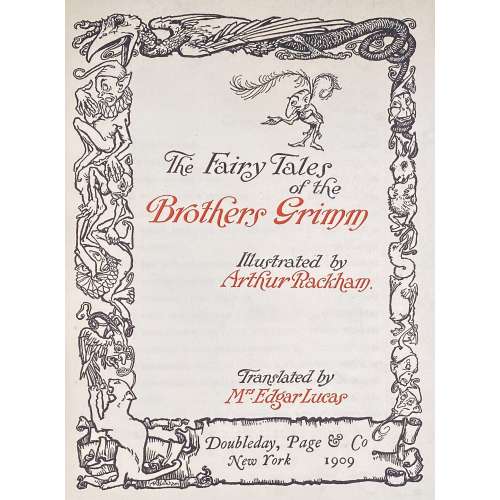 Title (black and red in pictorial frame): The Fairy Tales | of the | Brothers Grimm | Illustrated by Arthur Rackham. | Translated by | Mrs. Edgar Lucas | Doubleday, Page & Co | New York 1909. Pagination: [i-iv] – h.t., t.p., frontis., v-xv [xvi], 1-325 [326] colophon., [1 blank sheet], bfl; 40 tipped-in color plates (offset chromolithograph) with lettered guards, numerous in-text woodcuts. Collation: 4to; a-b4, A-2S4. Edition: 1st deluxe American large-paper edition, limited to 50 copies, Rackham’s facsimile signature to h.t. verso. Binding: Original full limp suede binding with yapp edges, gilt-ornamented and lettered spine. Top edge gilt, other uncut. Moiré endpapers. Printed on laid paper. Marbled endpapers.
Title (black and red in pictorial frame): The Fairy Tales | of the | Brothers Grimm | Illustrated by Arthur Rackham. | Translated by | Mrs. Edgar Lucas | Doubleday, Page & Co | New York 1909. Pagination: [i-iv] – h.t., t.p., frontis., v-xv [xvi], 1-325 [326] colophon., [1 blank sheet], bfl; 40 tipped-in color plates (offset chromolithograph) with lettered guards, numerous in-text woodcuts. Collation: 4to; a-b4, A-2S4. Edition: 1st deluxe American large-paper edition, limited to 50 copies, Rackham’s facsimile signature to h.t. verso. Binding: Original full limp suede binding with yapp edges, gilt-ornamented and lettered spine. Top edge gilt, other uncut. Moiré endpapers. Printed on laid paper. Marbled endpapers. -
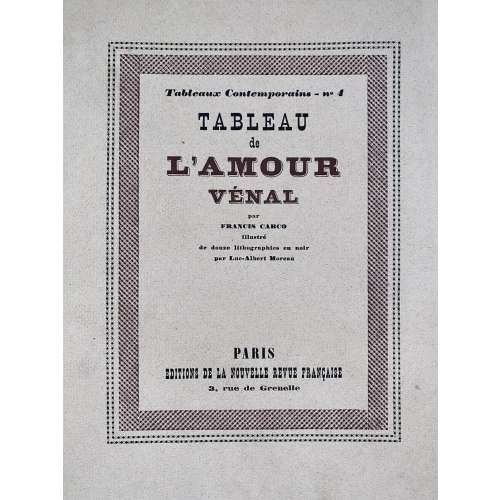 Description: Softcover, French flapped wrappers, lettered front, back (advert.) and spine, collated in-4to, 24.3 x 20.2 cm, printed on thick wove paper Vélin pur fil Lafuma-Navarre, print run limited to 335 copies from which this is copy № 219; outer margin untrimmed, some leaves uncut, glassine DJ. Limitation: 1 copy (A) on Japon Impérial + double suite of plates + suite of original drawings, 4 copies (B-E) on Japon Impérial + double suite of plates, 15 copies on on Japon Impérial + suite of plates on Vieux Japon teinté (F-T), 315 copies on Vélin pur fil Lafuma-Navarre, of which 15 (I-XV) not for sale. Copyright: Libraire Gallimard, 1924. Printed: March 10, 1924 – text by Coulouma (Argenteuil) under direction of H. Barthélemy, lithographs printed by Marchizet (Paris). Front wrapper (in letterpress two-colour border): Tableaux Contemporains – no 4 | . TABLEAU | de | L'AMOUR | VÉNAL | par | FRANCIS CARCO | Illustré | de douze lithographies en noir | par Luc-Albert Moreau | PARIS | ÉDITIONS DE LA NOUVELLE REVUE FRANÇAISE | 3, rue de Grenelle || Title-page: Same, without a frame, in black, L'AMOUR | VÉNAL in brown. Collation: 4to; 14 a4 2-164, total 68 leaves with wrappers included in collation plus 12 plates, incl. frontispiece, extraneous to collation. Pagination: [2 wrapper] [6] [i] ii-vii [viii blank] [9] 10-122 [2 colophon] [2 blank] [2 wrapper]; total 136 pages incl. wrappers, plus ils. Contributors: Francis Carco [François Carcopino-Tusoli] (French, 1886 – 1958) – author. Luc-Albert Moreau (French, 1882 – 1948) – artist. La Nouvelle Revue Française (nrf) (Paris)– publisher. Gaston Gallimard (French, 1881 – 1975) – publisher.
Description: Softcover, French flapped wrappers, lettered front, back (advert.) and spine, collated in-4to, 24.3 x 20.2 cm, printed on thick wove paper Vélin pur fil Lafuma-Navarre, print run limited to 335 copies from which this is copy № 219; outer margin untrimmed, some leaves uncut, glassine DJ. Limitation: 1 copy (A) on Japon Impérial + double suite of plates + suite of original drawings, 4 copies (B-E) on Japon Impérial + double suite of plates, 15 copies on on Japon Impérial + suite of plates on Vieux Japon teinté (F-T), 315 copies on Vélin pur fil Lafuma-Navarre, of which 15 (I-XV) not for sale. Copyright: Libraire Gallimard, 1924. Printed: March 10, 1924 – text by Coulouma (Argenteuil) under direction of H. Barthélemy, lithographs printed by Marchizet (Paris). Front wrapper (in letterpress two-colour border): Tableaux Contemporains – no 4 | . TABLEAU | de | L'AMOUR | VÉNAL | par | FRANCIS CARCO | Illustré | de douze lithographies en noir | par Luc-Albert Moreau | PARIS | ÉDITIONS DE LA NOUVELLE REVUE FRANÇAISE | 3, rue de Grenelle || Title-page: Same, without a frame, in black, L'AMOUR | VÉNAL in brown. Collation: 4to; 14 a4 2-164, total 68 leaves with wrappers included in collation plus 12 plates, incl. frontispiece, extraneous to collation. Pagination: [2 wrapper] [6] [i] ii-vii [viii blank] [9] 10-122 [2 colophon] [2 blank] [2 wrapper]; total 136 pages incl. wrappers, plus ils. Contributors: Francis Carco [François Carcopino-Tusoli] (French, 1886 – 1958) – author. Luc-Albert Moreau (French, 1882 – 1948) – artist. La Nouvelle Revue Française (nrf) (Paris)– publisher. Gaston Gallimard (French, 1881 – 1975) – publisher. -
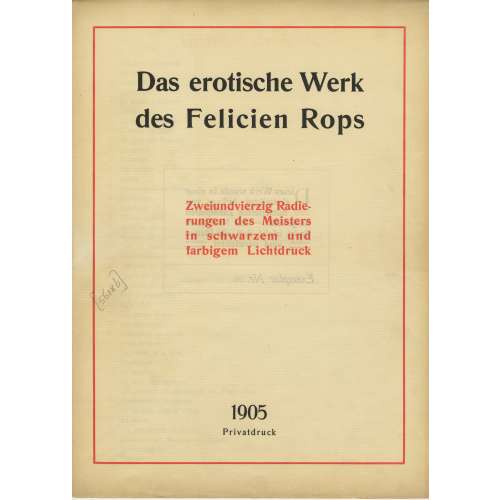
A limited-edition (№26/500) set of 42 etchings and drypoints after Félicien Rops (Belgian, 1833 – 1898), each mounted in a numbered passe-partout, printed posthumously by an anonym in Germany in 1905; in a flapped half faux suede-backed cardboard portfolio with straps, 442 x 335 mm, red embossed lettering to the front cover, bookplate of Richard Teschner (Austrian, 1879 – 1948) pasted inside.
Title-page (in a red frame): Das erotische Werk | des Felicien Rops | Zweiundvierzig Radie- | rungen des Meisters | in schwarzem und | farbigem Lichtdruck | 1905 | Privatdruk ||
Limitation (in a red two-section frame) : Dieses Werk wurde in einer | einmaligen Auflage von | 500 numerierten Exemplaren | hergestellt. — Ein Nachdruck | findet nicht statt, die Platten | == sind vernichtet == | Exemplar Nr. 26 ||
Verzeichnis der Tafeln (Table of Contents): 1. Initiation sentimentale; 2. La croix; 3. Entre-acte; 4. Holocauste; 5. La bonne hollandaise; 6. Étude; 7. La femme au pantin; 8. L’amour de Satan; 9. Au pays des féminies; 10. La volupté; 11. Evocation; 12. De castitate; 13. Joujou; 14. Vengeance d’une femme; 15. Phantasies; 16. Indolence; 17. Théâtre gaillard; 18. Appel au peuple; 19. Masques modernes; 20. Tout est grand chez les rois; 21. Marie-Madeleine; 22. L’amante du Christ; 23. Feuille de vigne; 24. La messe de Guide; 25 Viol et prostitution; 26. Le maillot; 27. Les jeunes France; 28. Les diaboliques; 29. Coquetterie au miroir; 30. Jeune homme; 31. La femme et la mort; 32. Confidence; 33. La bergère; 34. La mère aux satyrions; 35. Les exercices de dévotion de Mr. Henri Roch; 36. Mademoiselle de Maupin; 37. Le bonheur dans le crime; 38. La sirène; 39. Les cabotinages de l’amour; 40. Document sur l’impuissance d’aimer; 41. A cœur perdu; 42. Curieuse.
-
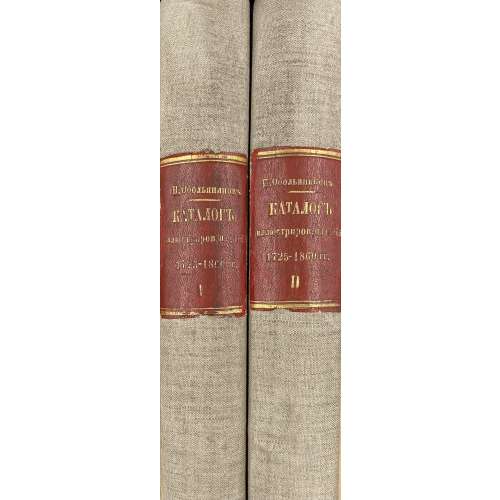 Two volumes, 32 x 24 cm each, uniformly bound in grey cloth with crimson morocco labels with gilt lettering to spine “Н. Обольяниновъ | КАТАЛОГЪ | иллюстриров. изданiй | 1725-1860 гг. | I (II)”, original wrappers preserved. To t.p. verso ink stamps “Latvijas PSR Zinātn̦u akadēmija Fundamentālā bibliotēka”, “1964”, “KATALOGS”, and “Z.A.B. Inv. № 80274”. Printed on laid paper, pagination throughout. 3,038 items with bibliographical descriptions. Title-page: КАТАЛОГЪ | РУССКИХЪ ИЛЛЮСТРИРОВАННЫХЪ | ИЗДАНIЙ | 1725—1860 гг. | — | СОСТАВИЛЪ | Н. Обольяниновъ. | Въ двухъ томахъ | Т. I (II). | ~ | МОСКВА – 1914 (1915). | Товарищество ТИПОГРАФIИ А. И. МАМОНТОВА, | Арбатская пл., Филипповский пер., д. № 11. || Vol. I: Collation: π6 1-424, total 174 leaves; pp.: [i-v] vi-xii, [1] 2-335 [336 errata] (total 348 pages); within green publisher’s wrappers. Vol. II: π2 1-444, total 178 leaves; pp.: [4] [337] 338-686 [687 errata], [688 blank] (total 356 pages); within green publisher’s wrappers. Provenance: Fundamental library of the Latvian Academy of Sciences. Contributors: Николай Александрович Обольянинов (Russian, 1868 – 1916) – author. Анатолий Иванович Ма́монтов (Russian, 1839 – 1905) – publisher.
Two volumes, 32 x 24 cm each, uniformly bound in grey cloth with crimson morocco labels with gilt lettering to spine “Н. Обольяниновъ | КАТАЛОГЪ | иллюстриров. изданiй | 1725-1860 гг. | I (II)”, original wrappers preserved. To t.p. verso ink stamps “Latvijas PSR Zinātn̦u akadēmija Fundamentālā bibliotēka”, “1964”, “KATALOGS”, and “Z.A.B. Inv. № 80274”. Printed on laid paper, pagination throughout. 3,038 items with bibliographical descriptions. Title-page: КАТАЛОГЪ | РУССКИХЪ ИЛЛЮСТРИРОВАННЫХЪ | ИЗДАНIЙ | 1725—1860 гг. | — | СОСТАВИЛЪ | Н. Обольяниновъ. | Въ двухъ томахъ | Т. I (II). | ~ | МОСКВА – 1914 (1915). | Товарищество ТИПОГРАФIИ А. И. МАМОНТОВА, | Арбатская пл., Филипповский пер., д. № 11. || Vol. I: Collation: π6 1-424, total 174 leaves; pp.: [i-v] vi-xii, [1] 2-335 [336 errata] (total 348 pages); within green publisher’s wrappers. Vol. II: π2 1-444, total 178 leaves; pp.: [4] [337] 338-686 [687 errata], [688 blank] (total 356 pages); within green publisher’s wrappers. Provenance: Fundamental library of the Latvian Academy of Sciences. Contributors: Николай Александрович Обольянинов (Russian, 1868 – 1916) – author. Анатолий Иванович Ма́монтов (Russian, 1839 – 1905) – publisher. -
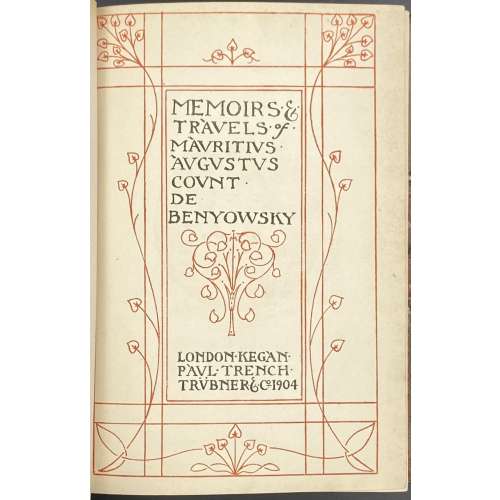 Title: MEMOIRS AND TRAVELS | OF | MAURITIUS AUGUSTUS COUNT DE | BENYOWSKY | MAGNATE OF THE KINGDOMS OF HUNGARY AND POLAND, ONE OF | THE CHIEFS OF THE CONFEDERATION OF POLAND | ETC., ETC. | Consisting of his Military Operations in Poland, his Exile into Kamchatka, | his Escape and Voyage from that Peninsula through the Northern | Pacific Ocean, touching at Japan and Formosa, to Canton | in China, with an Account of the French Settle- | ment he was appointed to form upon the | Island of Madagascar | WITH AN INTRODUCTION, NOTES AND BIBLIOGRAPHY | BY | CAPTAIN S. PASFIELD OLIVER || Half-title (ornamental, in black and red): MEMOIRS & | TRAVELS of | MAURITIUS | AUGUSTUS | COUNT | DE | BENYOWSKY | LONDON•KEGAN• | PAUL•TRENCH• | TRÜBNER•&•Co 1904 || Pagination: [i, ii] – owner pasted wood engraving “A woman of Kamchatka” / Dryden House advert., [iii, iv] – serial title / MAB (years), frontis. Portrait of MAB by Walter L. Colls w/guard, [v, vi] – ornamental h.t / copyright, [vii, viii] – t.p. / list of ill., ix-xxxvi, 1-635 [636]. Collation: 2 blank leaves (binding), [a]-b8 c2 1-398 406, 2 plates, 2 blank leaves (binding). Binding: Modern ¾ morocco over marbled boards, raised bands, gilt fleur-de-lis-cross in compartments, burgundy label with gilt lettering, by Atkinson Book Binders, Salisbury (sticker to back pastedown). Contributors: Printed by Neill and Co., Edinburgh. Published by Kegan Paul, Trench, Trübner & Co.; Kegan Paul, Charles (British, 1828 – 1902). Author: Maurice Auguste comte de Benyowsky [Мориц Август Бенёвский] (Polish-Slovak-Hungarian, 1746 –1786). Editor: Samuel Pasfield Oliver (British, 1838 – 1907). Translator: William Nicholson (British, 1753 – 1815). Originally published in 1790, in London (I have not seen it anywhere) and in Dublin by P. Wogan [etc.], and in 1791 in French, in Paris by Buisson.
Title: MEMOIRS AND TRAVELS | OF | MAURITIUS AUGUSTUS COUNT DE | BENYOWSKY | MAGNATE OF THE KINGDOMS OF HUNGARY AND POLAND, ONE OF | THE CHIEFS OF THE CONFEDERATION OF POLAND | ETC., ETC. | Consisting of his Military Operations in Poland, his Exile into Kamchatka, | his Escape and Voyage from that Peninsula through the Northern | Pacific Ocean, touching at Japan and Formosa, to Canton | in China, with an Account of the French Settle- | ment he was appointed to form upon the | Island of Madagascar | WITH AN INTRODUCTION, NOTES AND BIBLIOGRAPHY | BY | CAPTAIN S. PASFIELD OLIVER || Half-title (ornamental, in black and red): MEMOIRS & | TRAVELS of | MAURITIUS | AUGUSTUS | COUNT | DE | BENYOWSKY | LONDON•KEGAN• | PAUL•TRENCH• | TRÜBNER•&•Co 1904 || Pagination: [i, ii] – owner pasted wood engraving “A woman of Kamchatka” / Dryden House advert., [iii, iv] – serial title / MAB (years), frontis. Portrait of MAB by Walter L. Colls w/guard, [v, vi] – ornamental h.t / copyright, [vii, viii] – t.p. / list of ill., ix-xxxvi, 1-635 [636]. Collation: 2 blank leaves (binding), [a]-b8 c2 1-398 406, 2 plates, 2 blank leaves (binding). Binding: Modern ¾ morocco over marbled boards, raised bands, gilt fleur-de-lis-cross in compartments, burgundy label with gilt lettering, by Atkinson Book Binders, Salisbury (sticker to back pastedown). Contributors: Printed by Neill and Co., Edinburgh. Published by Kegan Paul, Trench, Trübner & Co.; Kegan Paul, Charles (British, 1828 – 1902). Author: Maurice Auguste comte de Benyowsky [Мориц Август Бенёвский] (Polish-Slovak-Hungarian, 1746 –1786). Editor: Samuel Pasfield Oliver (British, 1838 – 1907). Translator: William Nicholson (British, 1753 – 1815). Originally published in 1790, in London (I have not seen it anywhere) and in Dublin by P. Wogan [etc.], and in 1791 in French, in Paris by Buisson.


